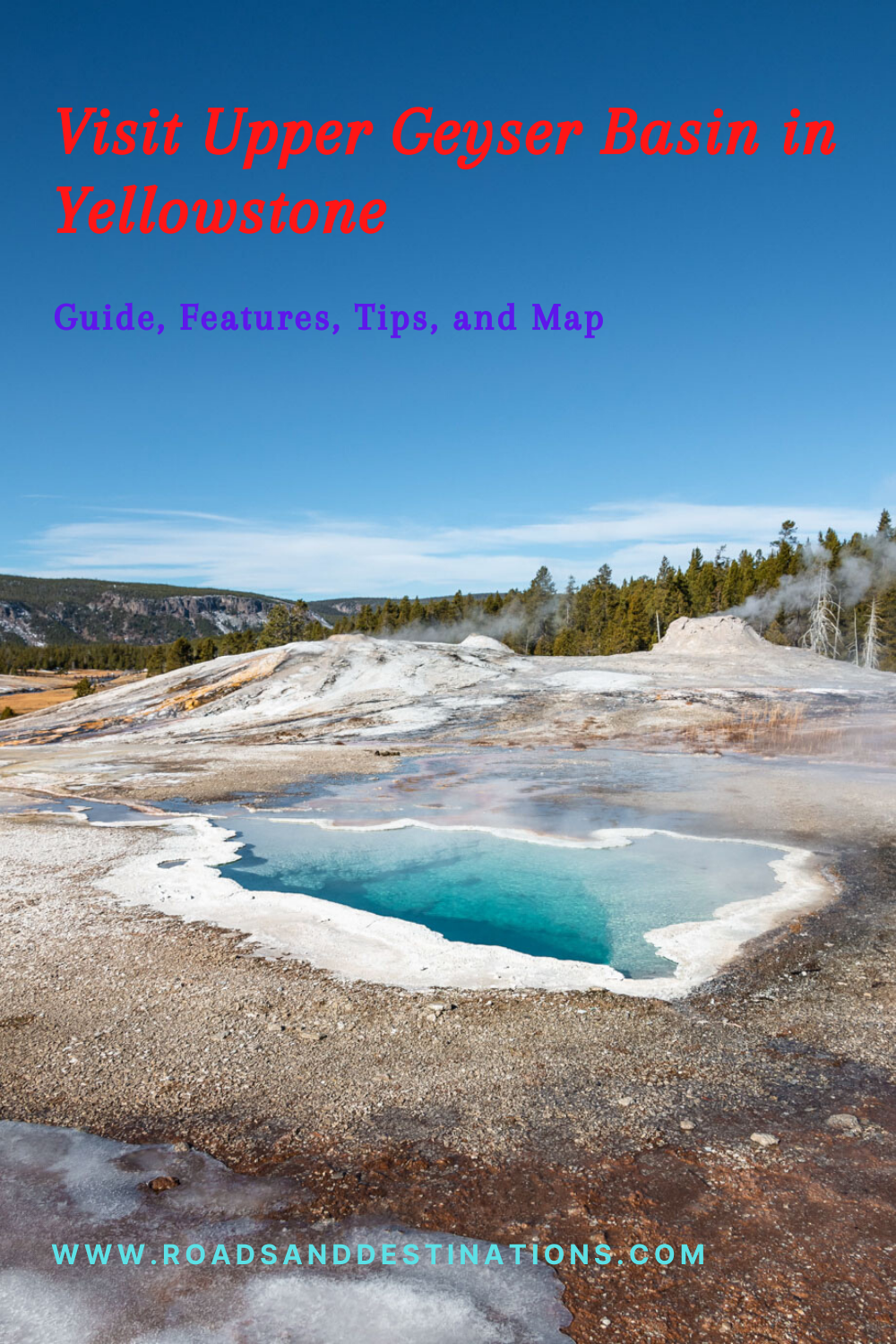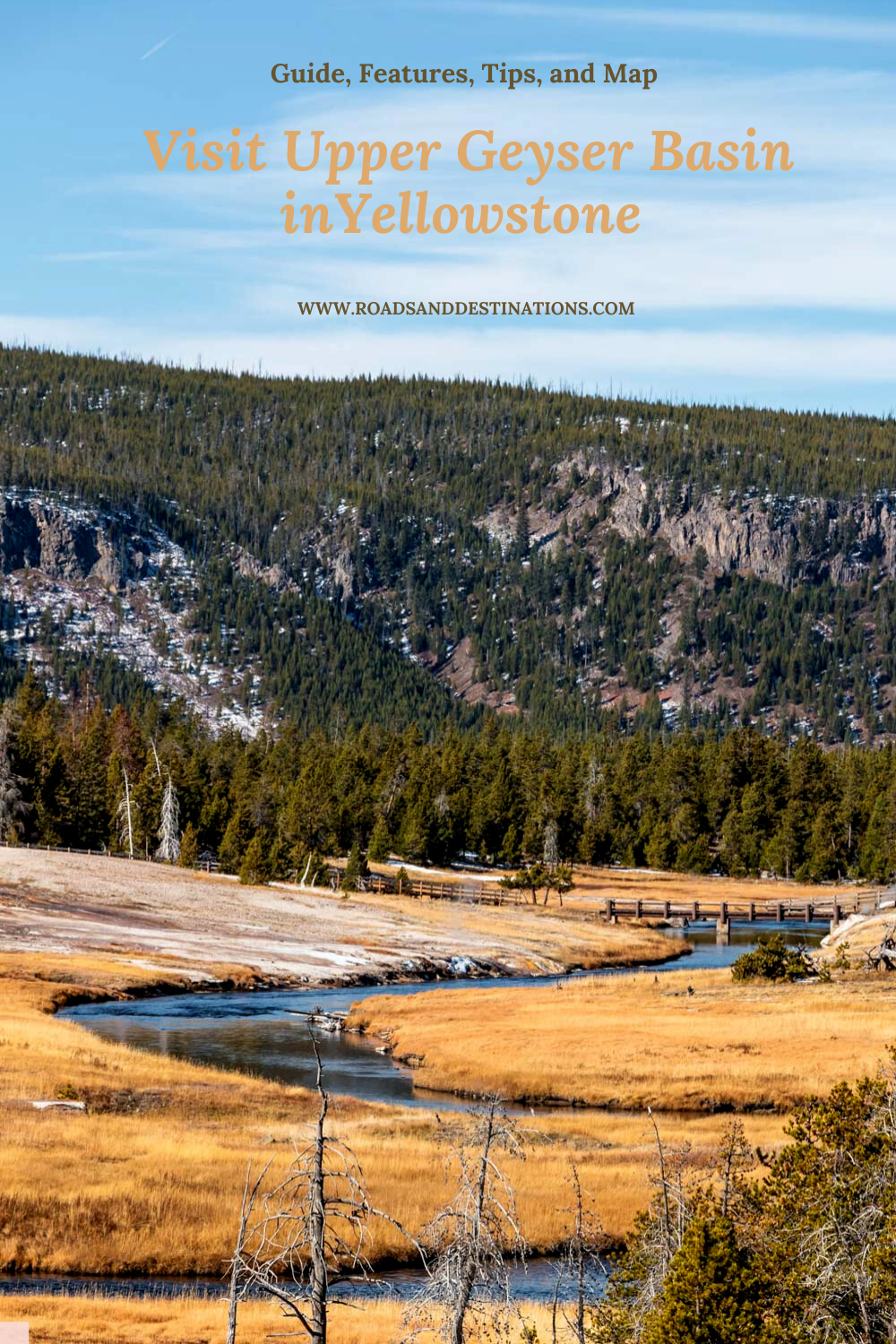The Upper Geyser Basin is one of a few places you absolutely must visit when in Yellowstone National Park. Boasting the largest concentration of geysers in the world, it offers the most unusual terrain you’ve ever seen.
Last updated: December 10, 2025
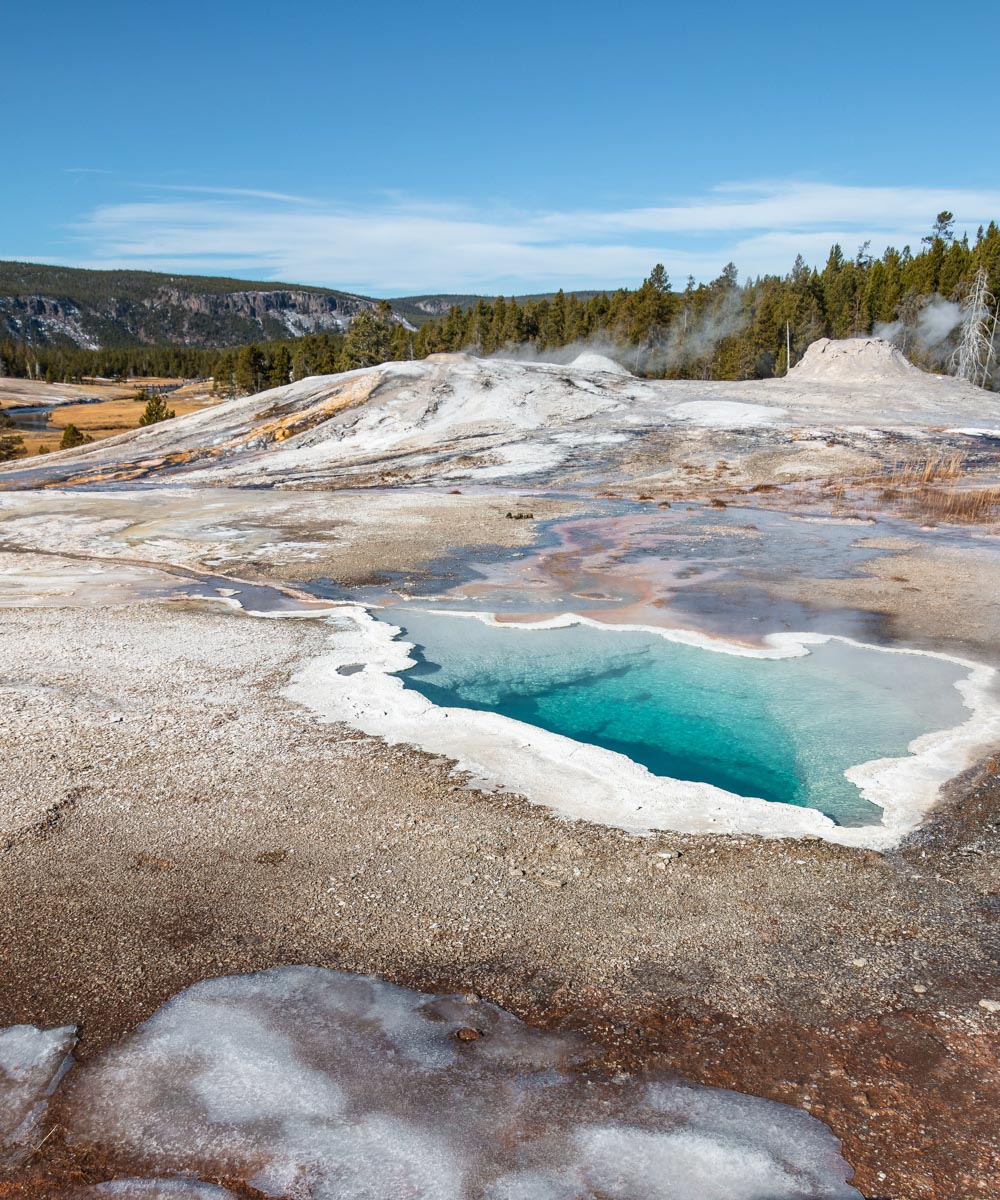
Upper Geyser Basin: The Most Visited Place in Yellowstone
The first visit to Yellowstone National Park may be overwhelming due to its ample basins and hundreds of sites you won’t see anywhere else. But even if you have no clue how you can fit all these abundant natural wonders in your itinerary, one thing you do not want to miss: Old Faithful Geyser. One of the most predictable geysers in the park, Old Faithful resides in the remarkable Upper Geyser Basin.
Home to hundreds of other hydrothermal features, the basin is hands down the most incredible area in the national park.
In this guide to visiting the Upper Geyser Basin in Yellowstone, we’ve compiled the list of the most interesting sites to see in Wyoming. Furthermore, the guide goes on to explain why you need to visit the Upper Geyser Basin, what to expect here, and how to get to its signature landmarks.
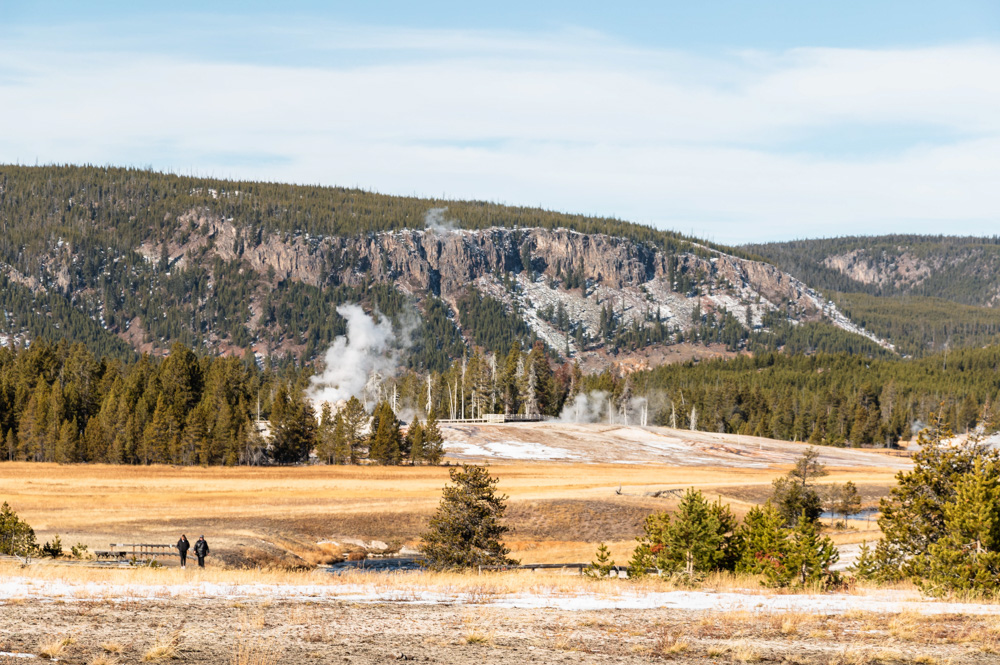
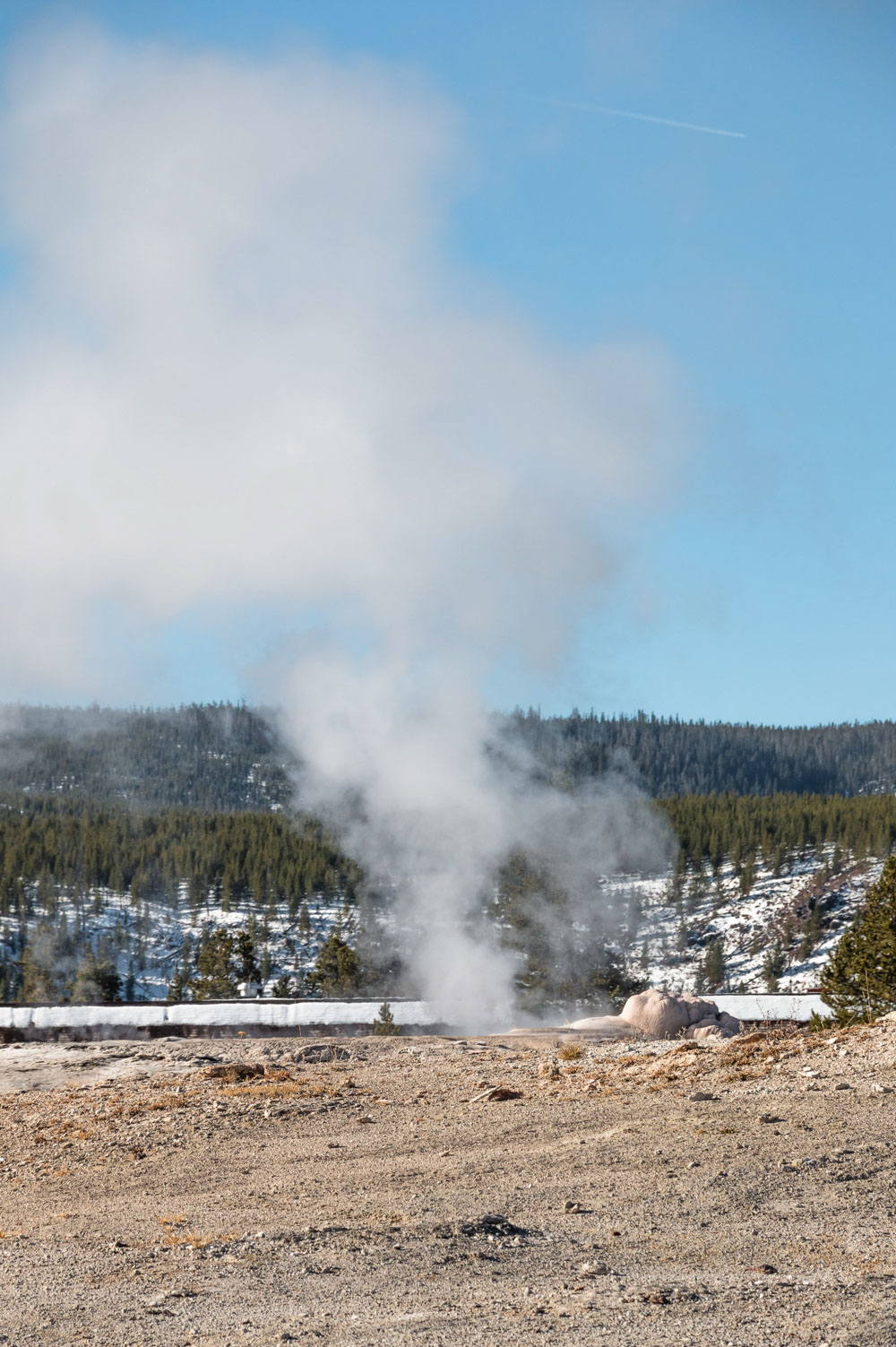
Visit Upper Geyser Basin in Yellowstone: Meet the Basin
History in a Nutshell
While the majority of the travelers visit the Upper Geyser Basin to see Old Faithful, the place is so much more than just its world-famous geyser. Discovered in the 1870s, the remarkable area astounded even its first accidental visitors.
Hissing and puffing clouds of mist along with jets of boiling water into the air, it raised the explorers’ interest on the spot. The members of the 1870 Washburn-Langford-Doane Expedition couldn’t help but keep a close eye on the remarkable natural wonders abounded in the basin.
Peculiarities and Names
According to Nathaniel P. Langford, the early explorers named many of the hitherto obscure hydrothermal features of the area based on their peculiarities. Even during a visit to the Upper Geyser Basin today, you can’t disagree with their choices, so profoundly describing the structural or behavior patterns of the geysers and hot springs.
While the story of predictable eruptions of Old Faithful that eventually led to its name is known to almost every visitor of Yellowstone, the other hydrothermal features in the basin are yet to impress their guests.
We spent hours observing the geysers and springs during our afternoon visit to the Upper Geyser Basin. Indeed, the peculiar shapes and grand eruptions aligned with the names of the majority of the hydrothermal features. Whether it was the intrinsic contour of Ear Spring or the distinct outline of Heart Spring, the first visitors of the basin captured the essence of each and every site they named.
The Highest Concentration of Geysers
The appellations, however, are not the most interesting aspect that inspire millions of people to visit the Upper Geyser Basin every year. The area is the largest basin in the park. Furthermore, the Upper Geyser Basin has gained its recognition as a place with the highest concentration of geysers in the world.
TIP: If you want to learn more about Yellowstone and the Upper Geyser Basin, read our article 10 Interesting Facts about Yellowstone
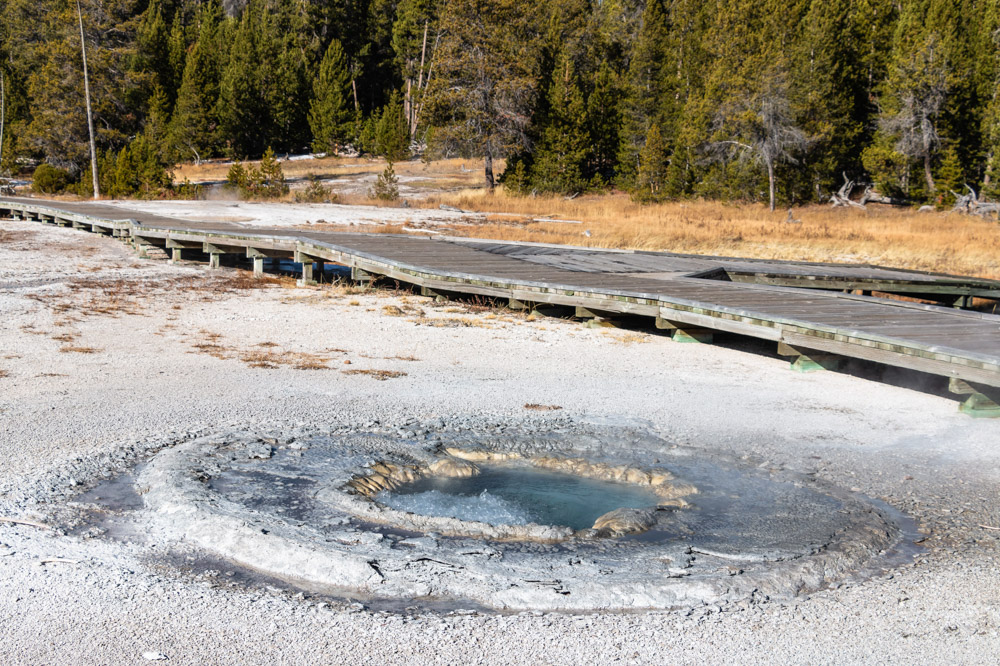
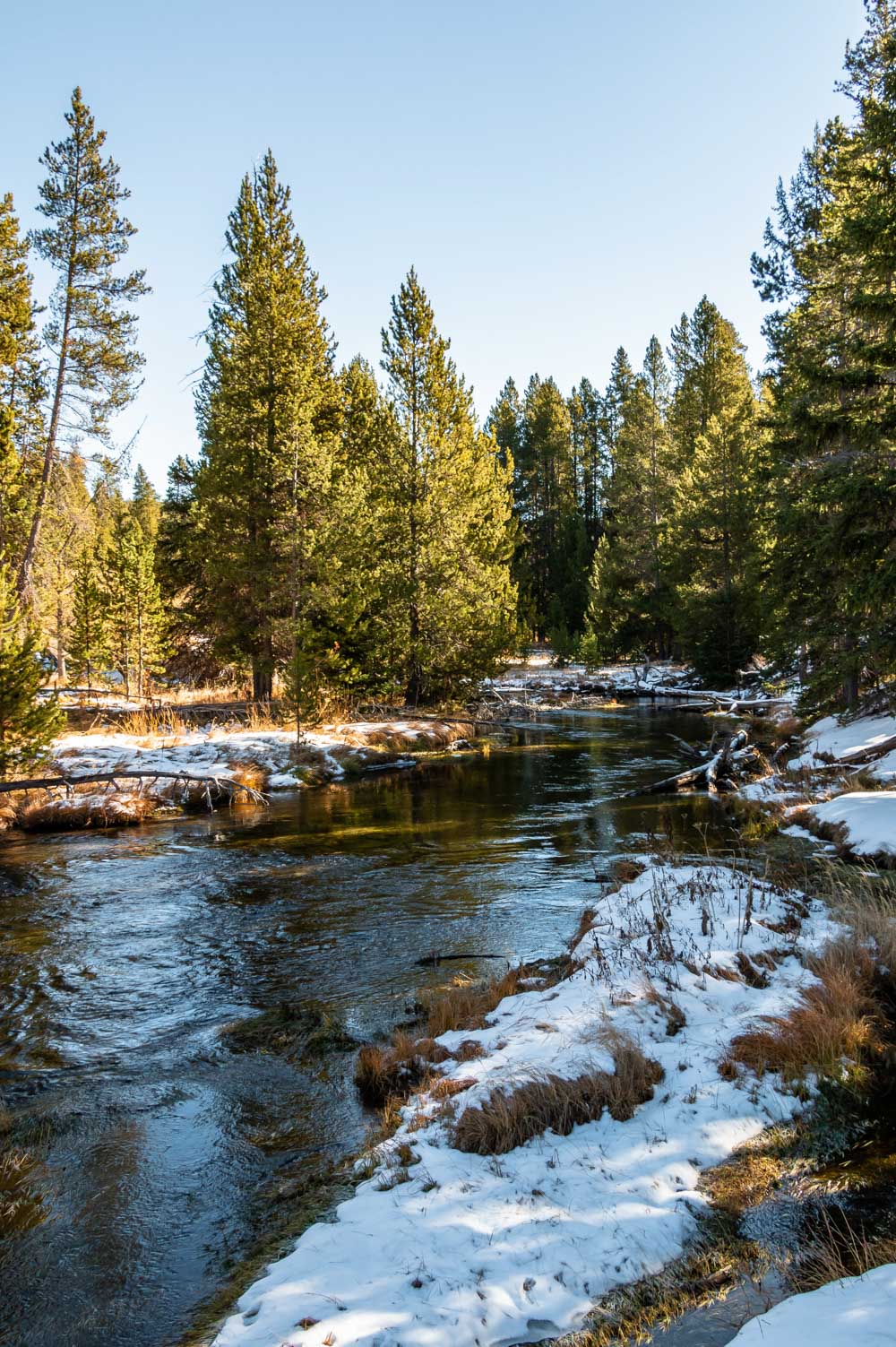
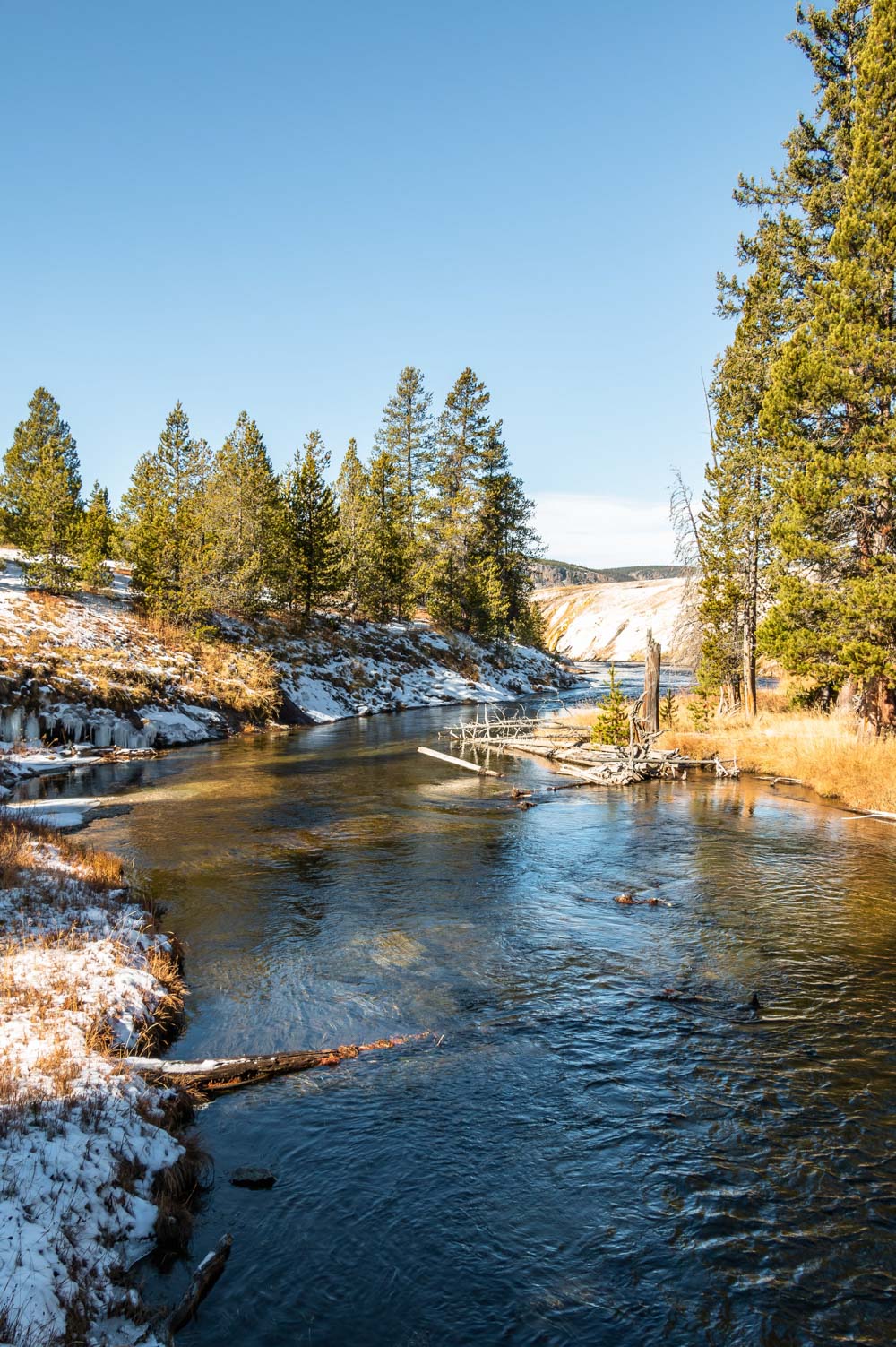
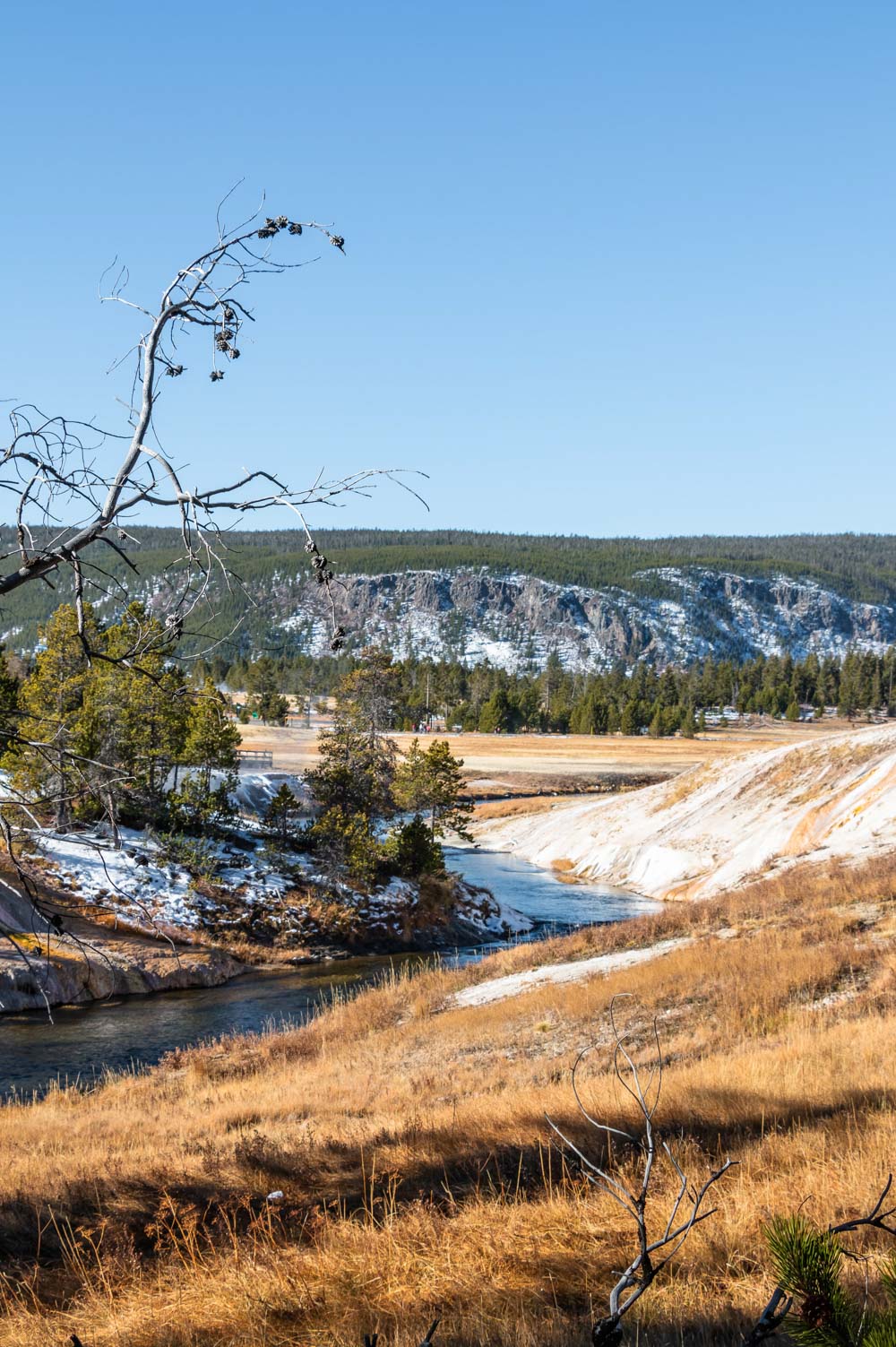
Location and Areas to Visit in Upper Geyser Basin
Spanning the region between the Old Faithful area and the Grand Loop Road, the Upper Geyser Basin boasts several groups of hot springs, including more than 150 geysers. 1,392 documented hydrothermal features exist in this less than a half-mile-wide area. The number, however, might be larger as new geysers can emerge at any time.
The majority of the hydrothermal features are nestled near the Firehole River, in the farthest corners of the basin. The average temperature of the area’s natural wonders lingers at 168 degrees Fahrenheit. It’s too hot to handle for most of the living creatures. Countless boiling bubbles are certainly proof of it.
Considering the uniqueness of the area, the Upper Geyser Basin is one the most popular places to visit in Yellowstone National Park. Yet despite its wondrous abundance, the majority of the visitors barely make it past the Old Faithful area. Their loss, but great pleasure and less people around for those persistent visitors who venture to the remote sections of the basin.
Overall, the place consists of the famous Old Faithful area, Geyser Hill, the area between Castle Geyser and Morning Glory Pool, the Black Sand Basin, and the Biscuit Basin. Each of these sections harbor more hydrothermal features that one can possibly see during a day-trip to the Upper Basin.
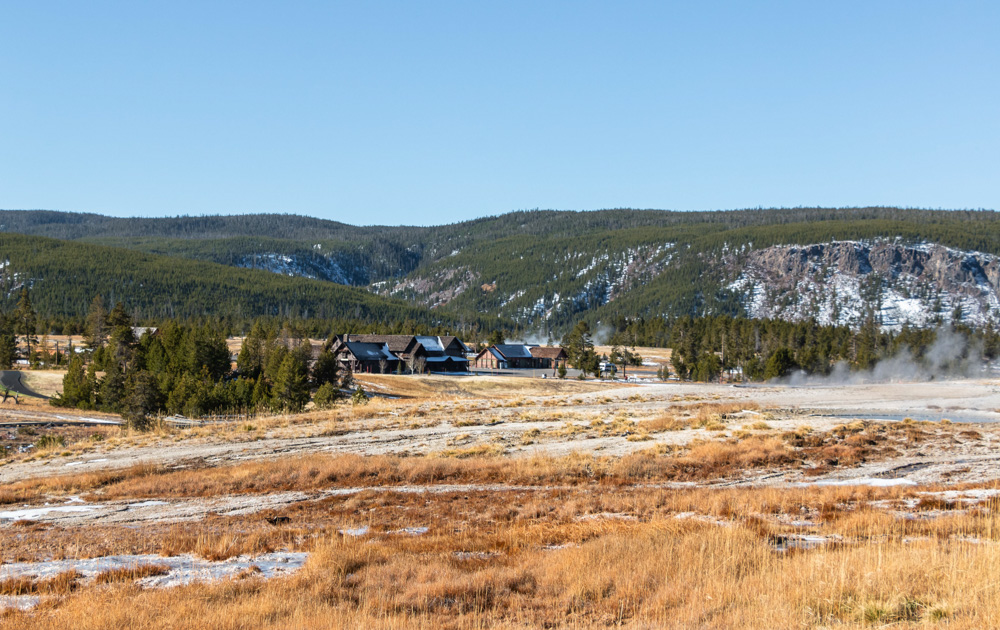
Reasons to Visit Upper Geyser Basin in Yellowstone National Park
Scenic views, bountiful hydrothermal features, and occasional wildlife – the Upper Geyser Basin never ceases to astound. Next time you’re in doubt, remember these two main reasons why you need to visit this section of Yellowstone National Park.
Admire Old Faithful
Home to the remarkable Old Faithful Geyser, the basin is the best place in Yellowstone to witness splashing geyser activity. The famous landmark of the Upper Geyser Basin was discovered in 1870. Eventually, Old Faithful became known as the most popular geyser in America.
Don’t let its fame bewilder you, though. The astounding hydrothermal feature is not even the largest geyser in Yellowstone, but one of the most predictable. Old Faithful erupts approximately every 95 minutes. Only five geysers in Yellowstone National Park are as reliable as this old fellow.
Explore Countless Hydrothermal Features of Different Shapes and Sizes
The Old Faithful area entices the majority of the guests of the Upper Geyser Basin. The oblivious visitors wait for the famous eruption while exploring the nearby hydrothermal features. They are on their way to other sections of Yellowstone National Park before giving the basin a chance to show all of its wonders.
A visit to the Upper Geyser Basin should, however, include much more than its popular predictable geyser. With hundreds of other hydrothermal features of different shapes, colors, and behaviors, the place is regarded as one of the most remarkable areas in the world. A myriad of the geysers and hot springs cluster next to each other, allowing you to feast your eyes on the most unusual features within a short walk from a large parking lot.
READ MORE: Don’t Skip Norris Geyser Basin in Yellowstone. Here’s Why
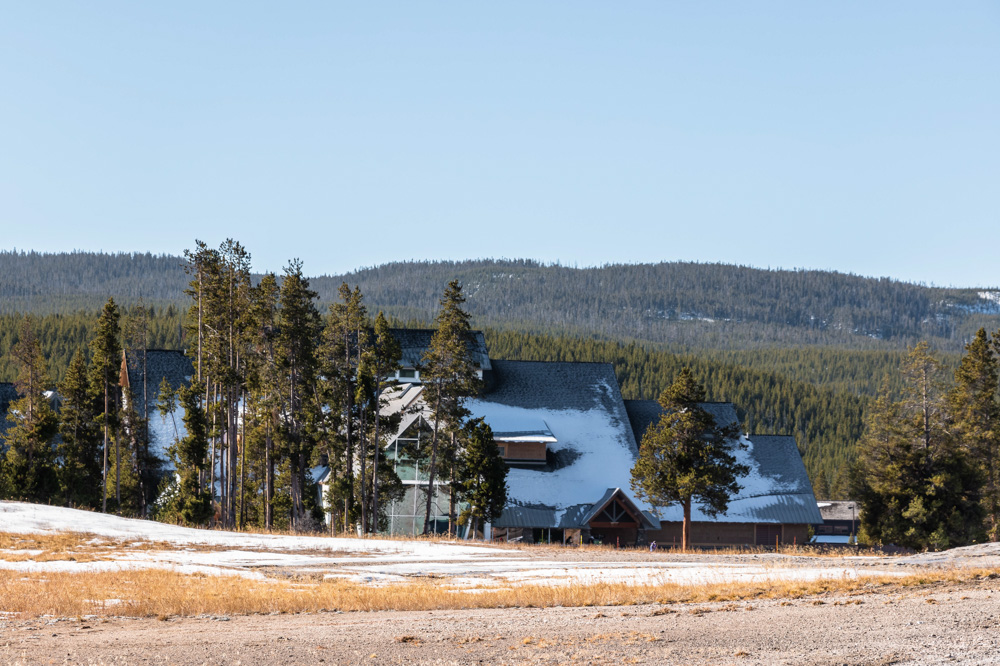
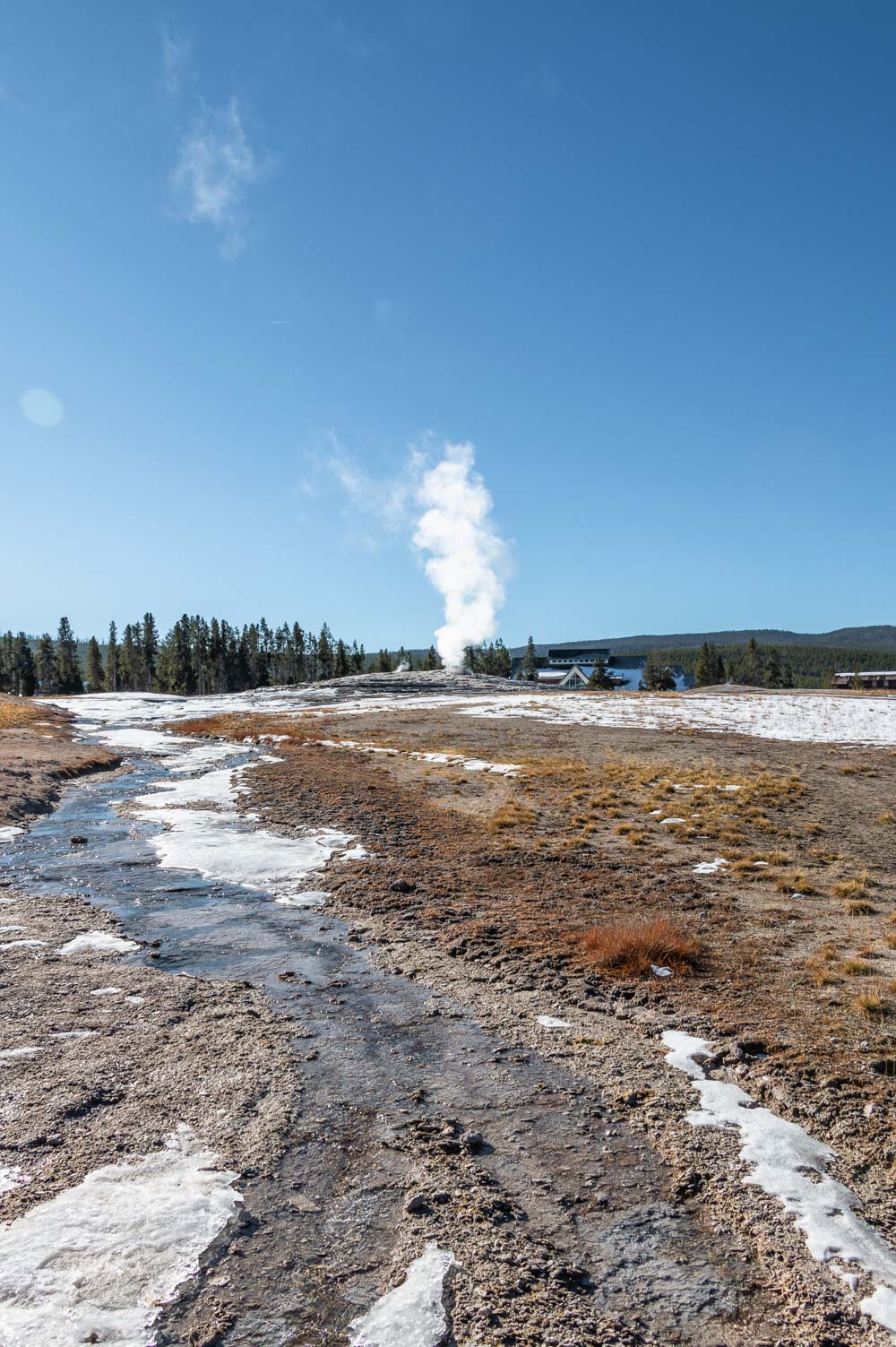
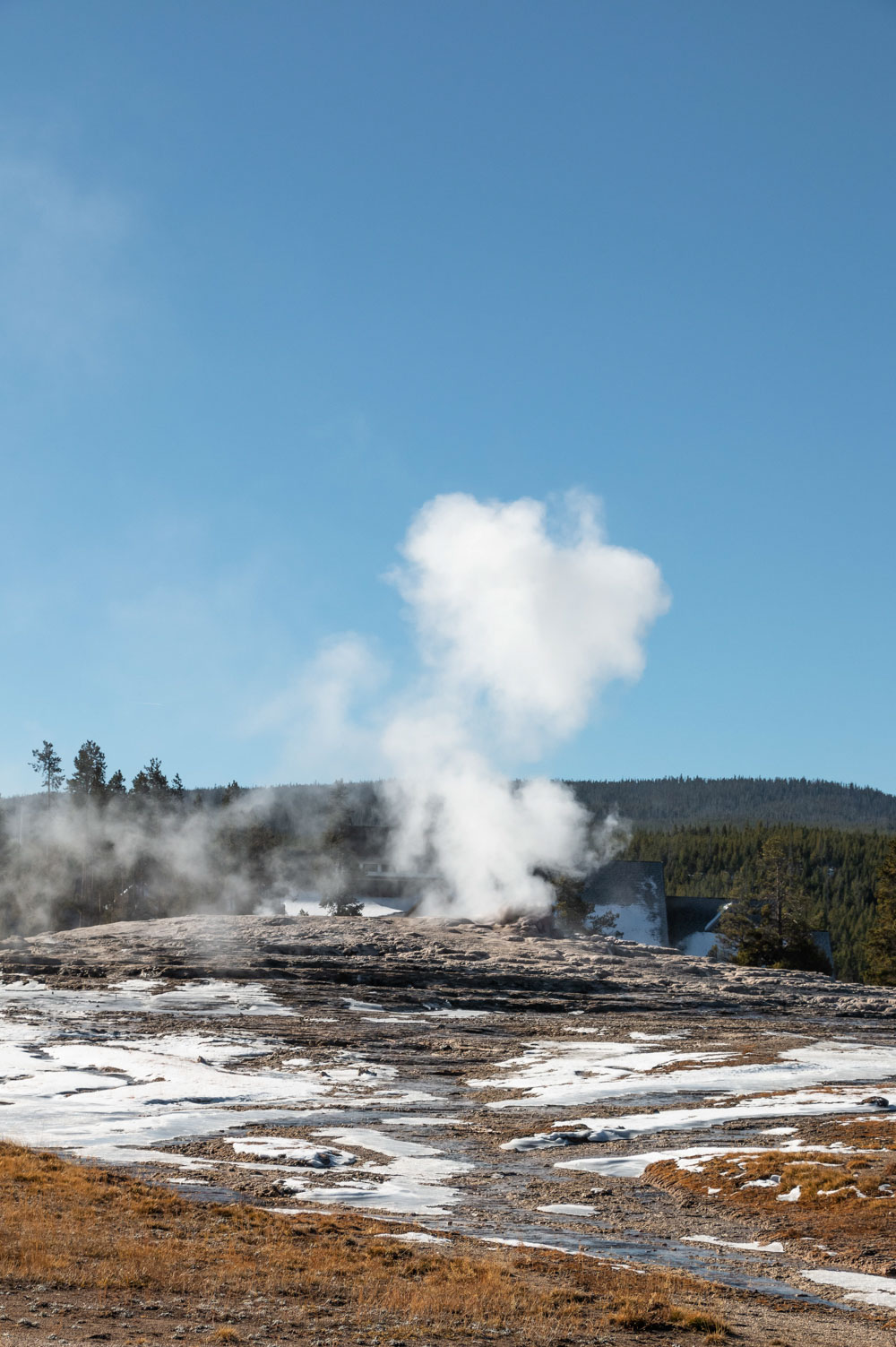
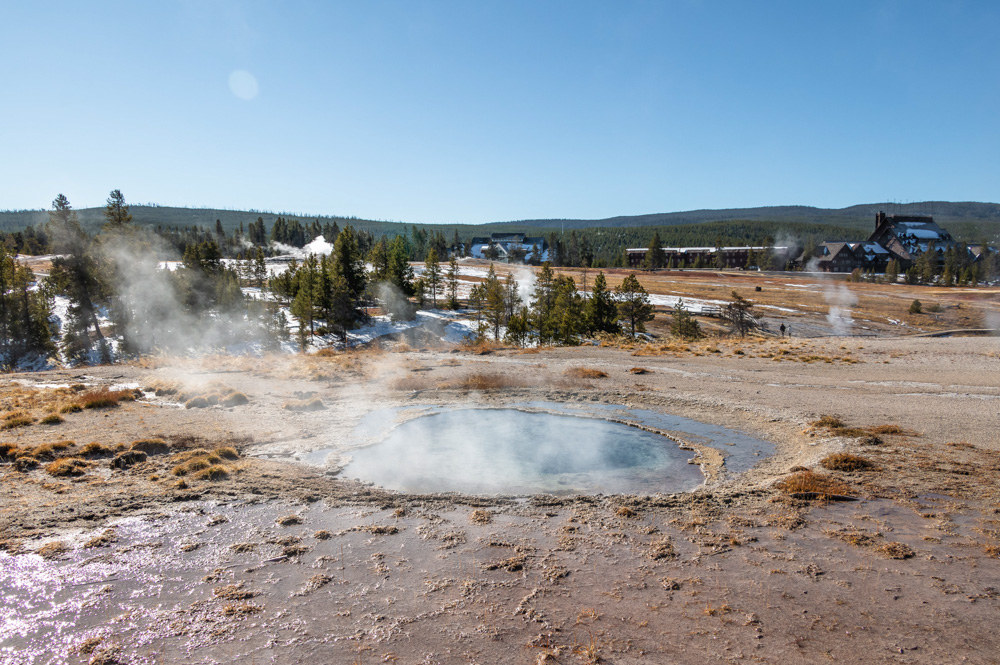
How Much Time Do You Need to Visit the Upper Geyser Basin?
You can spend the entire day in the area and not see all of its “inhabitants”. On average, spare anywhere from five to six hours to walk along raised boardwalks and designated trails here.
If you’re short on time, your visit to the Upper Geyser Basin can last anywhere from one hour (if you’re lucky to arrive right before the Old Faithful’s eruption) to a couple of hours. With only so much time on your hands, you should plan to explore the Old Faithful area and venture to Morning Glory Pool before heading to the next basin.
Note: The Old Faithful area is the busiest section of the Upper Geyser Basin. Far fewer visitors venture outside this place and head farther down along the Firehole River where the majority of the hydrothermal features are located.
TIP: Some farthest sections of the basin can be reached by car. Yet with smaller parking areas, claiming one spot for yourself can be an issue.
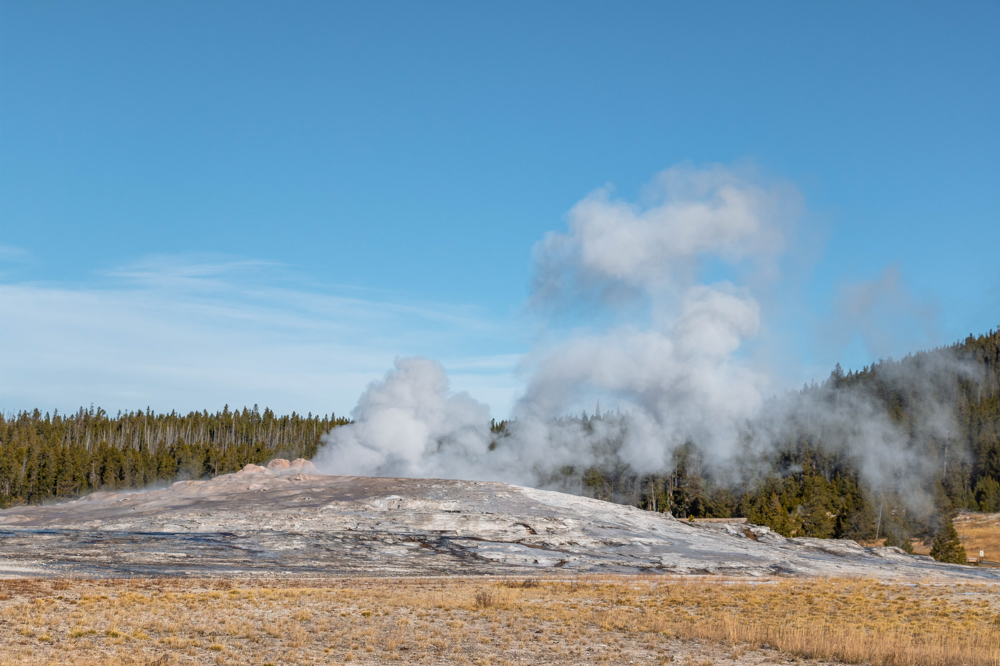
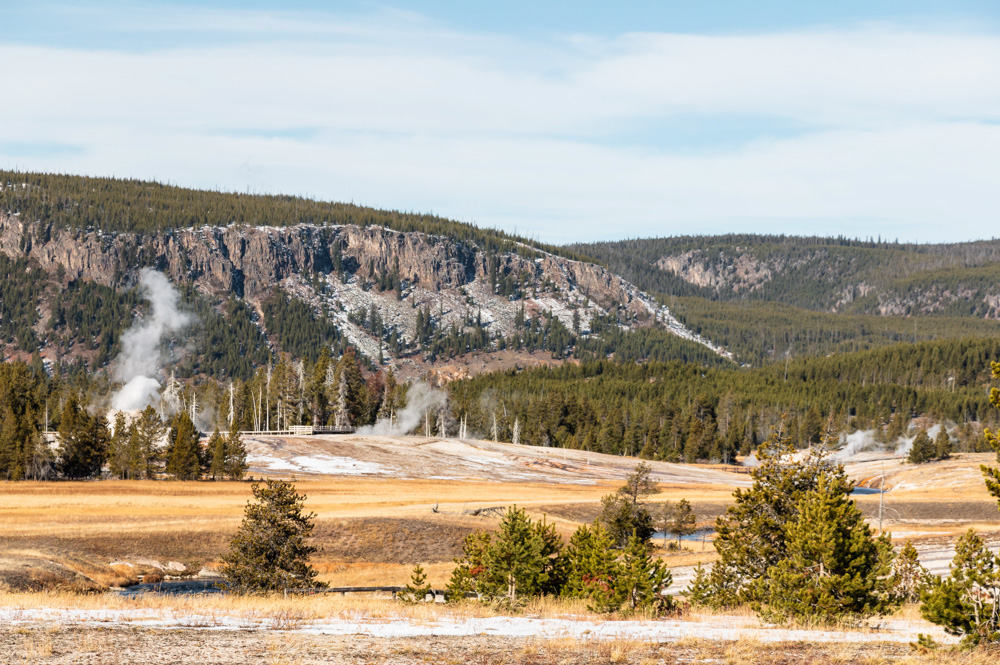
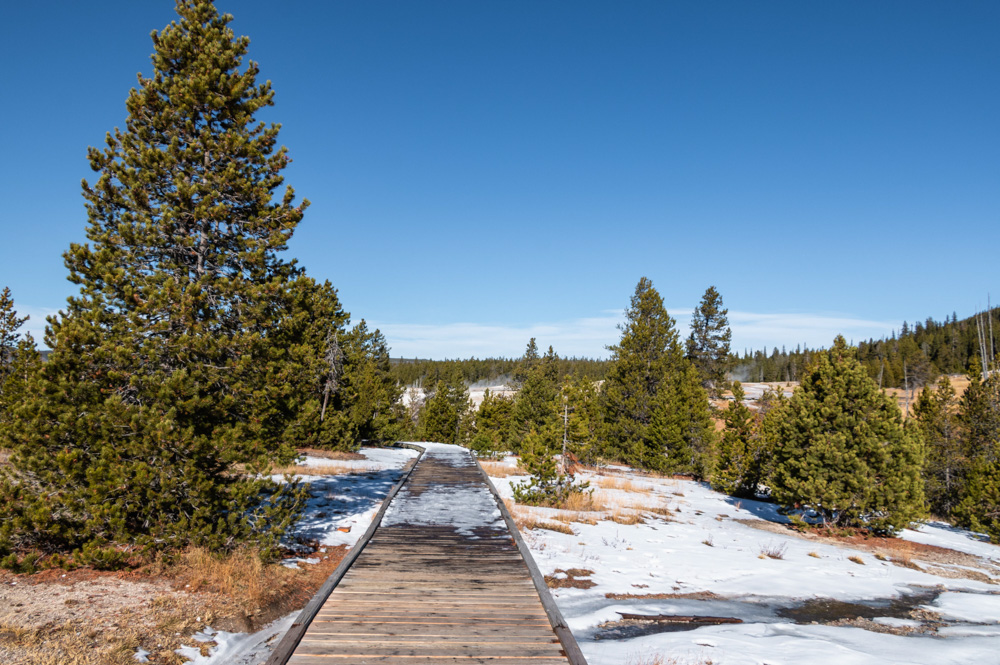
Where to Start Your Exploration of the Upper Geyser Basin
It’s safe to say that for the majority of the travelers a visit to the Upper Geyser Basin starts in the Old Faithful area, to be exact, the Old Faithful Visitor Center. Apart from its interactive exhibits and bits of history, the Visitor Center equips its guests with estimated times of next eruptions of the five predictable geysers (Old Faithful, Castle, Grand, Daisy, and Riverside).
There is no itinerary that can suit all Yellowstone’s explorers. Yet it’s recommended to plan your visit to the Upper Geyser Basin around the predictable geysers. Old Faithful erupts relatively frequently, while the other reliable hydrothermal features don’t really spoil you with their recurrent “shows”.
TIP: If the prediction table says that one of the four lesser-known geysers is about to erupt, check it out first. Old Faithful will alway be there when you come back.
Morning Glory is the second most visited place in the Upper Geyser Basin. The spring sits at the end of a one-mile paved trail that starts in front of the Old Faithful Inn. The round-trip hike can be successfully completed in one or two hours.
The End or the Beginning. For the majority of Yellowstone’s guests, seeing the erupted Old Faithful Geyser and admiring the vibrancy of Morning Glory conclude their trip to the basin. Only a handful of the nature enthusiasts strive to explore the other popular and lesser-known hydrothermal features in the area.
TIP: Regardless of which category of the visitors you fall into, don’t push yourself to the limit and try to see everything. Taking into account the amount of the documented geysers and springs residing in the Upper Geyser Basin, it’s simply impossible.
Visit Upper Geyser Basin: Map
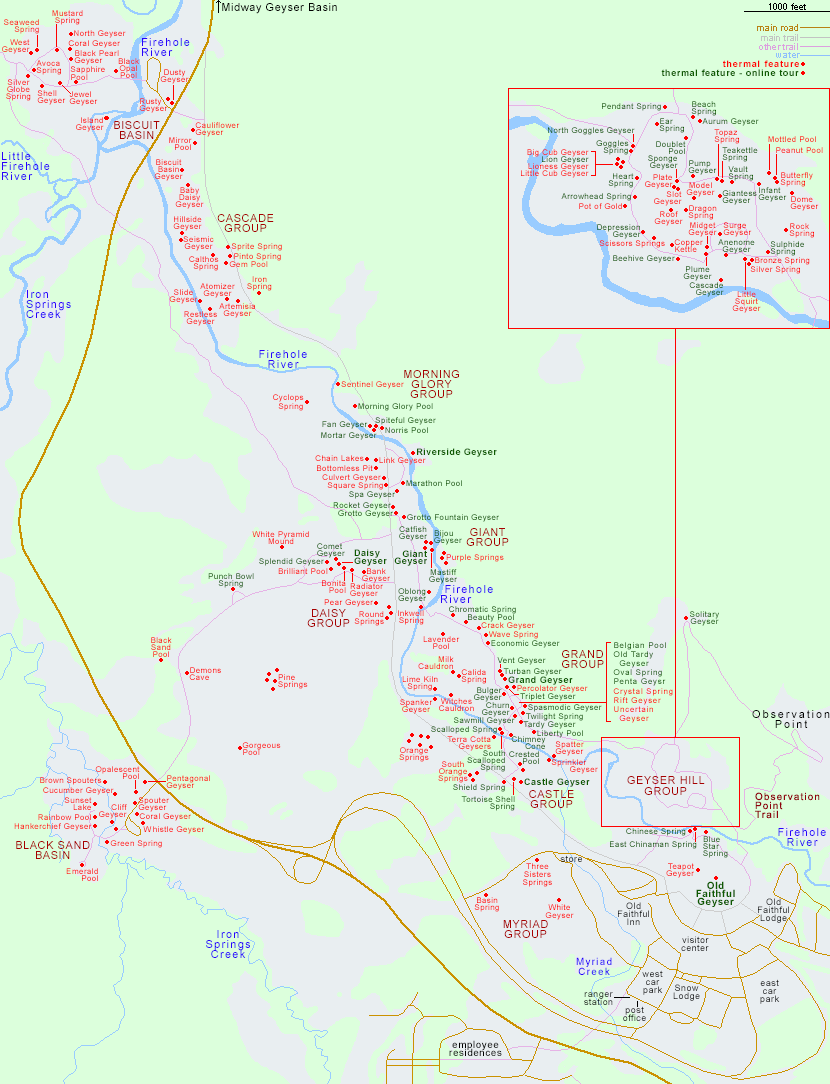
VISIT UPPER GEYSER BASIN: PLACES AND HYDROTHERMAL FEATURES BEYOND OLD FAITHFUL
OLD FAITHFUL AREA
Before we go into details of what you can see in the farthest corners of the Upper Geyser Basin, let’s make one more stop at the Old Faithful area. As we stated earlier, it’s the most popular section of the basin that encompasses Old Faithful Geyser, the Old Faithful Inn, and other natural and man-made attractions. Many travelers visit only this part of the basin, completely disregarding its secluded “neighborhoods”.
For more information about the Old Faithful area, the famous geyser, including its impressive eruptions, check out our Guide to Old Faithful Geyser in Yellowstone.
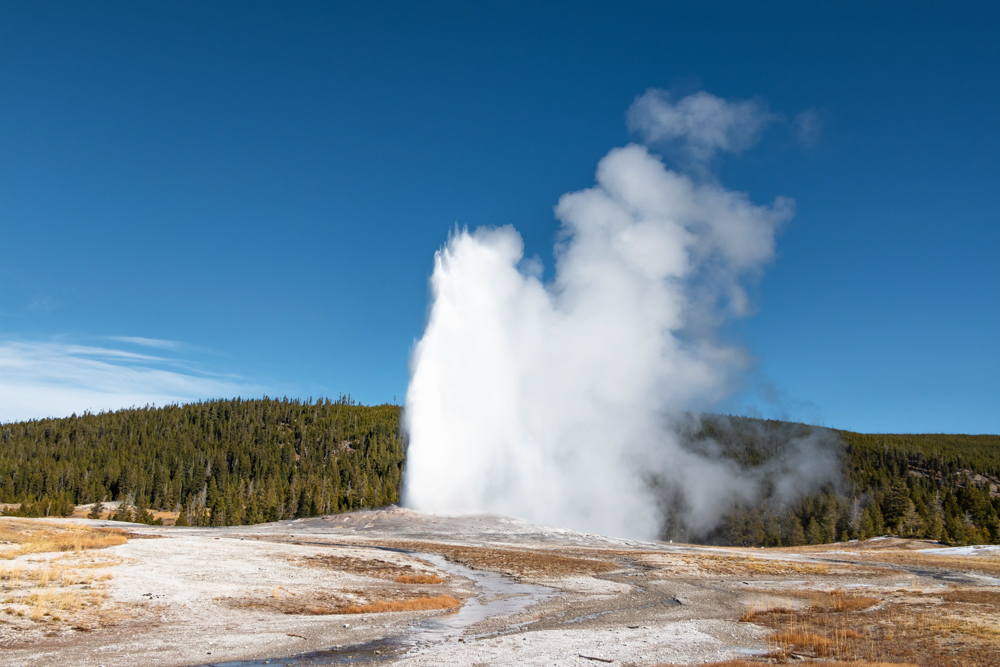
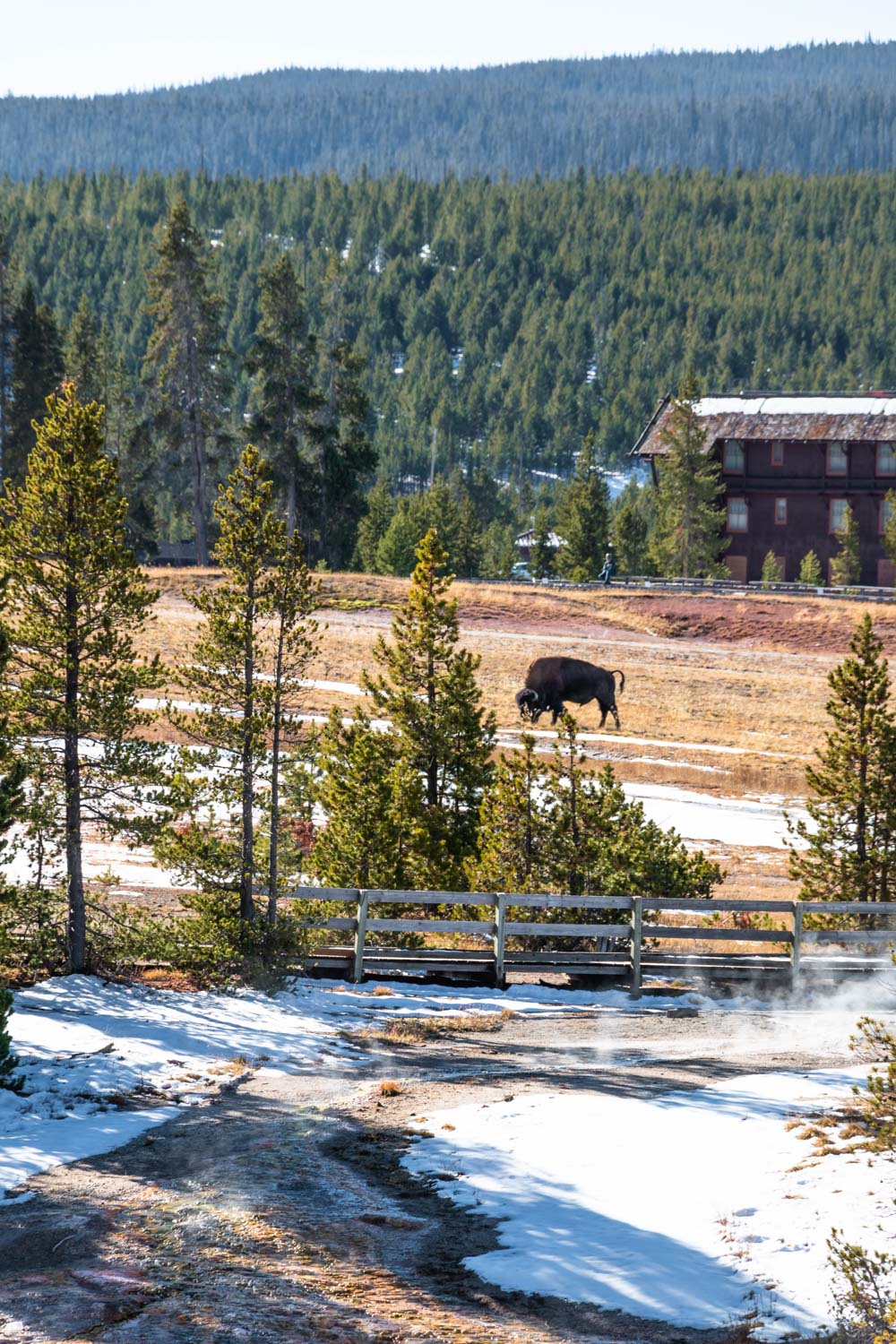
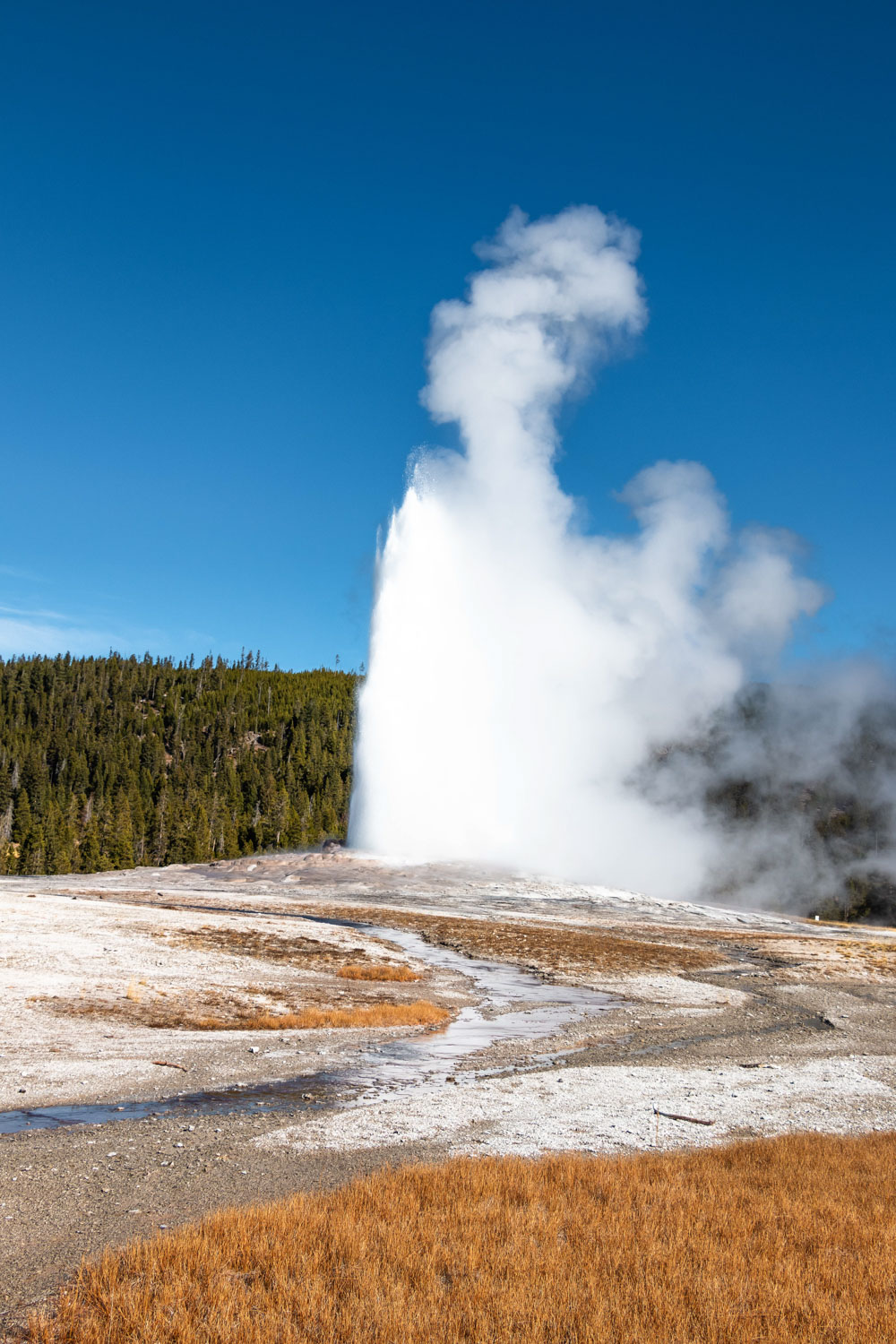
VISIT UPPER GEYSER BASIN: GEYSER HILL
Geyser Hill, located on the right bank of the Firehole River across from Old Faithful, is one of the most convenient places to linger at while waiting for Old Faithful’s eruptions. Close proximity as well as its numerous hot springs and more than 40 geysers ignite the interest, allowing to explore the area without spending too much time in this section of the Upper Geyser Basin. The most popular hydrothermal features here are Beehive and Giantess Geysers.
Many of the unique dwellers of Geyser Hill are joined through a myriad of underground tunnels. Relying on each other for energy and water supply, they change their behaviors in response to eruptions of their “neighbors”. All in all, Geyser Hill is known as one of the regions with the largest amount of the geysers, including multiple cone geysers and boiling hot springs.
Giantess Geyser
Giantess Geyser is the star of the Geyser Hill area. When active, it influences the behavior of many other hydrothermal features in the area. This, however, happens rarely and you might need to prolong your visit to the Upper Geyser Basin for months to witness this show.
To make things worse, this unpredictable geyser has long dormant periods. While erupting, though, it shoots out blasting jets of water to heights between 150 and 200 feet.
Beehive Geyser
Beehive Geyser, the second popular geyser in the area, is known for its four-foot-high beehive-shaped cone. Some insist, though, that the hydrothermal feature owes its name to its unprecedented sound during an eruption. It reminds you of an “angry swarm of bees”.
Although we didn’t get a chance to confirm it, the geyser’s remarkable shape stood out from all the rest. Moreover, Beehive Geyser is one the most powerful geysers in the basin. During the eruption, its narrow vent ejects columns of water as high as 200 feet.
Lion Geyser Complex
Four geysers and three hot springs comprise the Lion Geyser Complex: Lion Geyser, Lioness Geyser, Big Cub Geyser, Little Cub Geysers, Goggles Spring, North Goggles Geyser, and Kitten Geyser (unofficial name). As it becomes pretty clear at this point, these cone geysers along with the springs received their name due to their resemblance to a reclining lion.
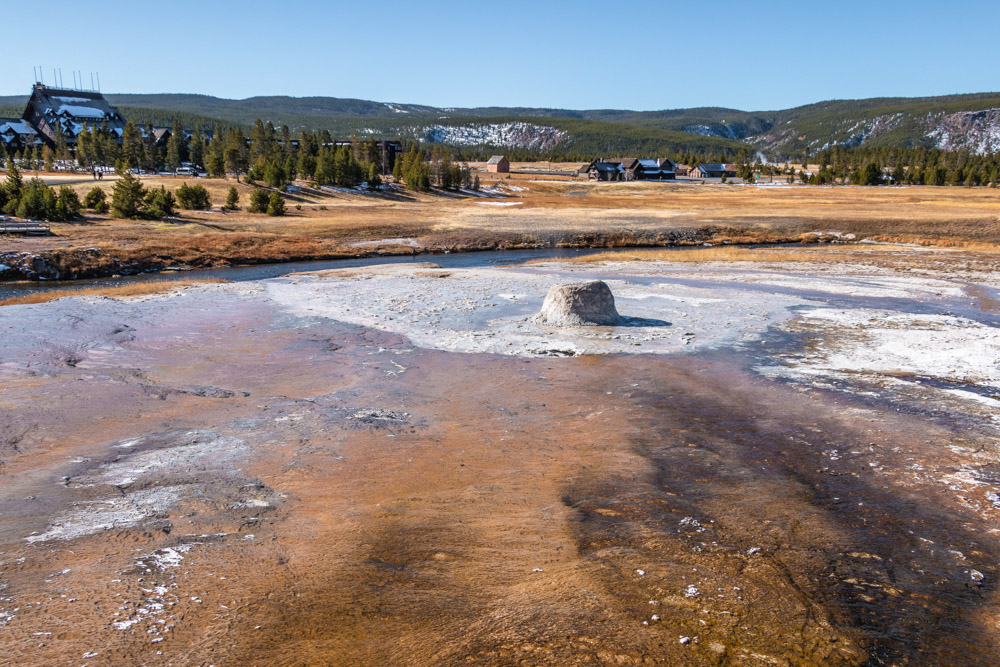
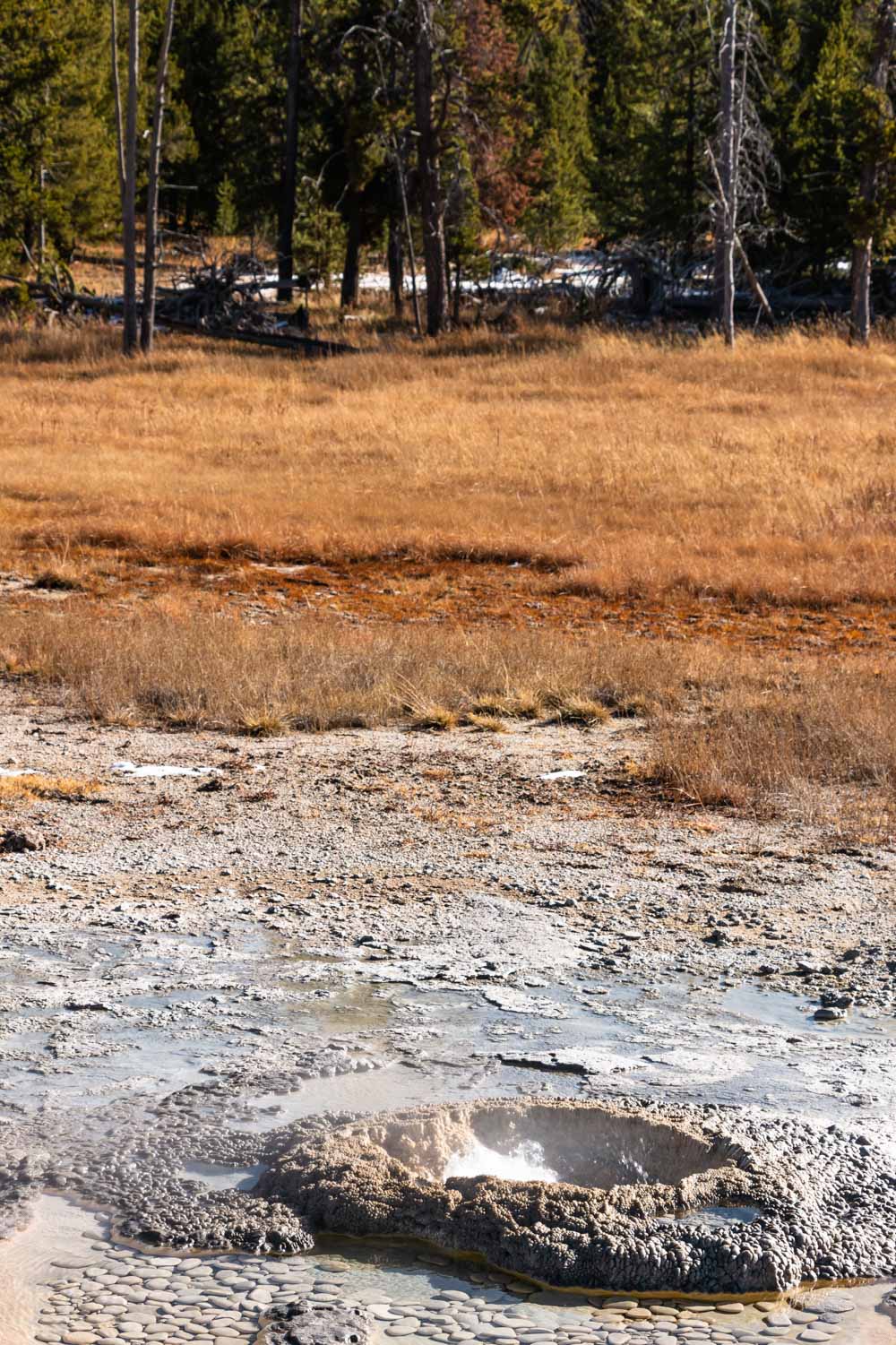
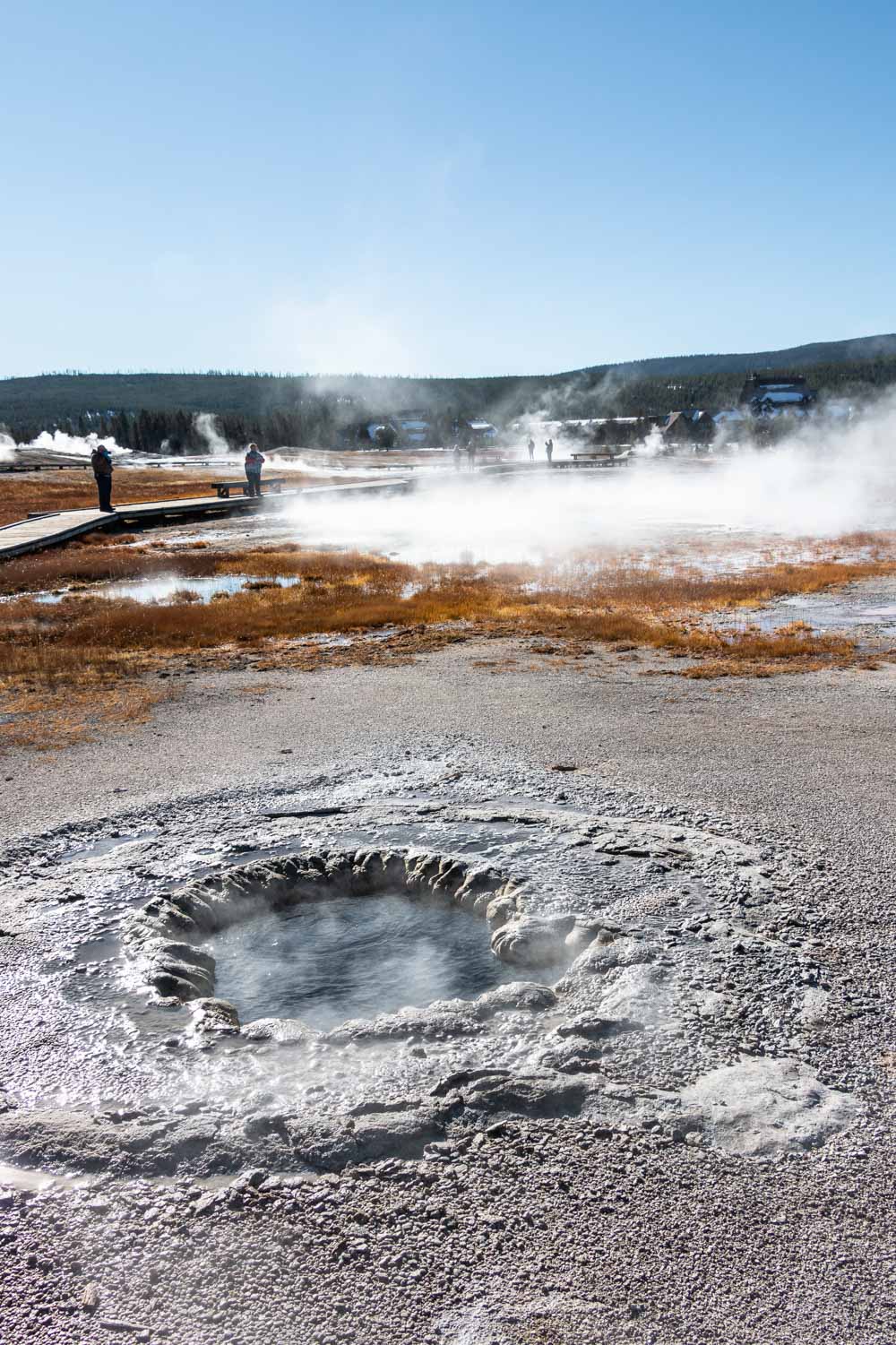
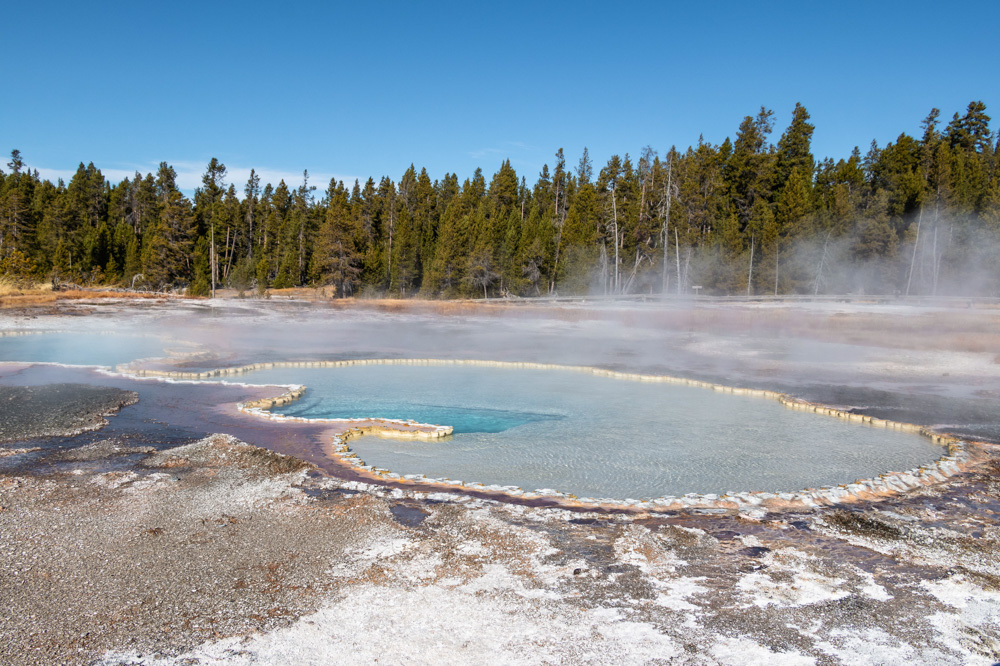
Aurum Geyser
Aurum Geyser might look small and harmless at first. Yet its infrequent, but impressive eruptions that range from 22 hours to more than 2 weeks attest to the incredible natural force trapped underground.
Heart Spring
Easily recognizable shape and the turquoise color of water make you linger near Heart Spring a little bit longer. Again, don’t let its pristine shade deceive you. Similar to the other hydrothermal features, this hot spring is dangerous for the majority of the living creatures. Its temperature fluctuates from 150 to 202 degrees Fahrenheit.
Blue Star Spring
Blue Star Spring is as deadly as Heart Spring. This “resident” of the Upper Geyser Basin doesn’t like any intruders and makes its guests pay dearly for any spontaneous visits. Apparently, a bison calf that fell in the pool in the mid-1980s paid with its life for trespassing, serving as a reminder that you can never be oblivious during a visit to the Upper Geyser Basin.
Ear Spring
From heart to ear shapes, the Upper Geyser Basin is desperate for human attention. Ear Spring that resembles a rather big human ear is an extremely hot pool whose temperature reaches 205 degrees Fahrenheit.
The ever-present bubbles attest to the dangerous side of the visually appealing hydrothermal feature. Pictures and videos usually do a great job at capturing these boiling globules.
Solitary Geyser
Solitary Geyser likes solitude. Hidden along the side trail to Observation Point, it was originally known as Solitary Spring. Recent eruptions, which occur every 4 to 8 minutes, however, have proved it wrong. The geyser shoots water up to 6 feet into the air. The incredible show can be seen from the boardwalk.
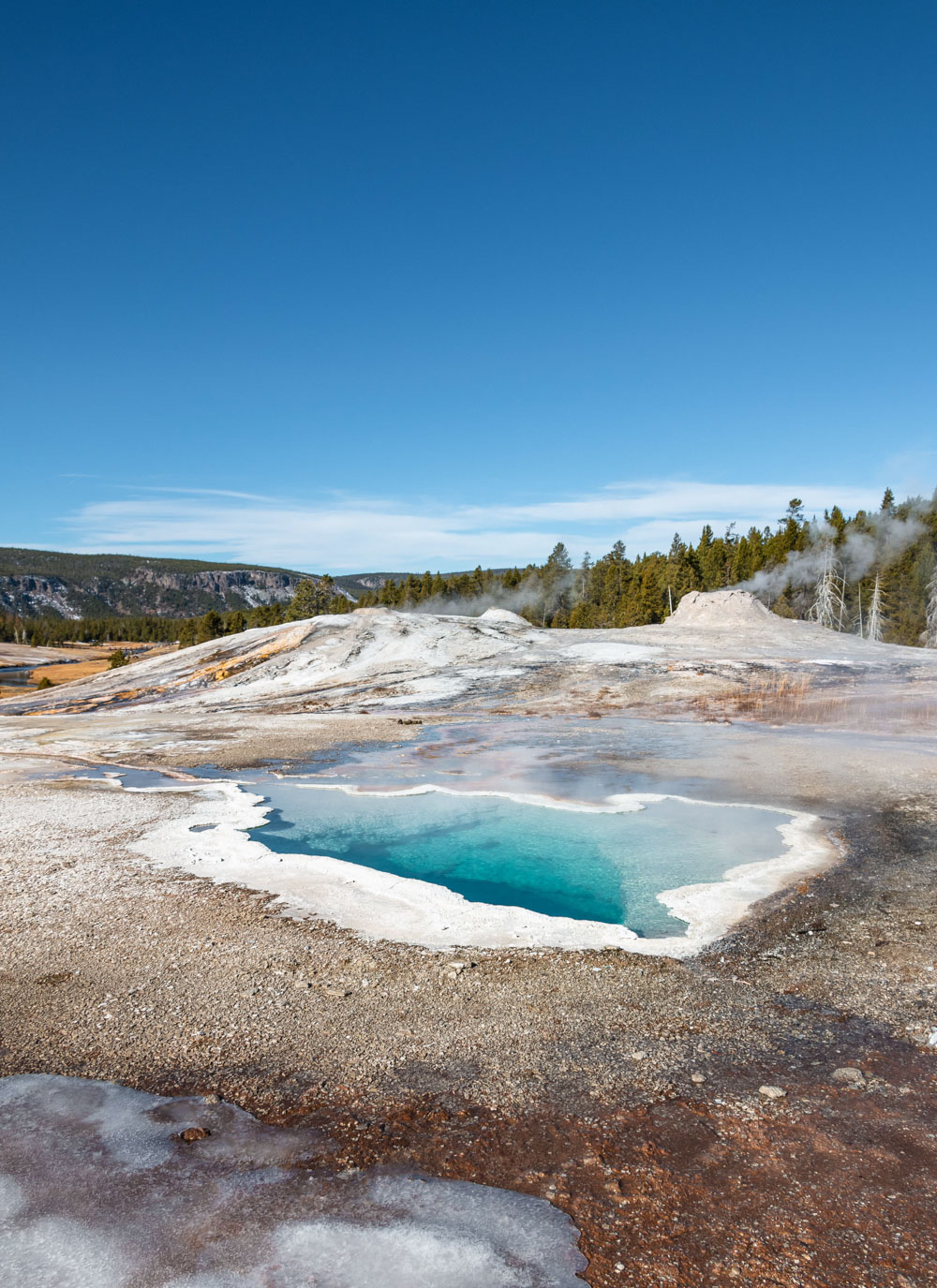
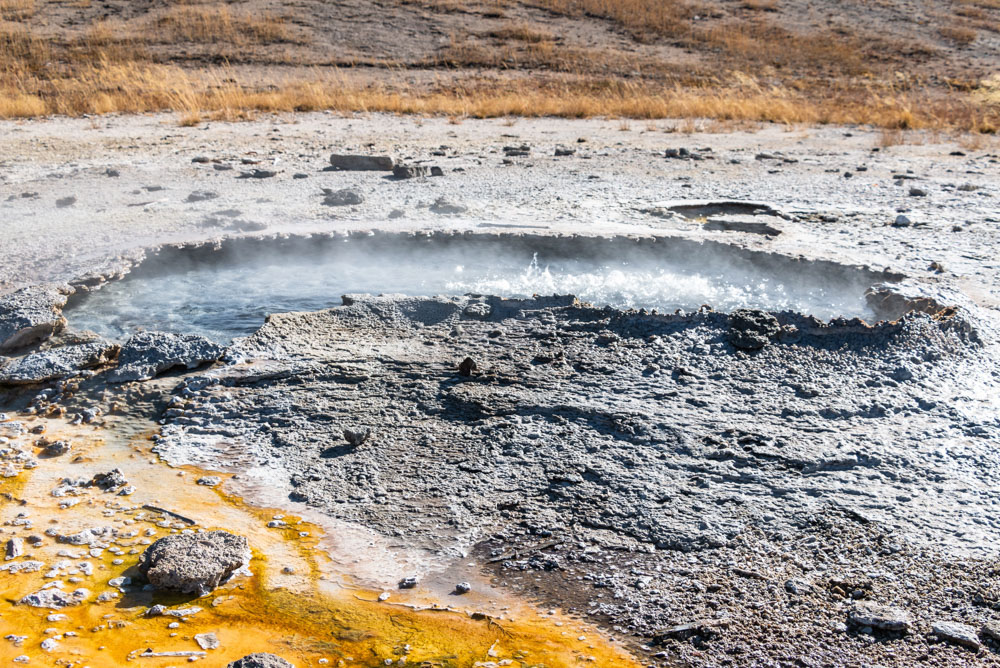
VISIT UPPER GEYSER BASIN: CASTLE GEYSER TO MORNING GLORY
The area between Castle Geyser and Morning Glory presents some of the most famous and stunning hydrothermal features in the world. Yet its rather distant location is to blame for a smaller number of visitors. Here are some of the favorite geysers and springs you can find in this section of the Upper Geyser Basin.
Sawmill Geyser Complex
The Sawmill Geyser Complex is densely populated with smaller hydrothermal features. The most incredible aspect about this complex, however, is its ability to turn on and turn off.
The features, grouped into two teams, have developed two distinct periods of activity: “Sawmill mode” and “Penta-Churn mode”. When the members of the first group are active, the second team experiences a period of inactivity, and vice versa.
Sawmill Geyser
The highlight of the Sawmill Complex is Sawmill Geyser. It depends on nearly 10 other hydrothermal features for its energy and water supply. Until 2017, Sawmill Geyser was one of the most active geysers to enjoy in the park. It put on a show more often than it remained quiet. Today, it’s mostly dormant.
Grand Group
The Grand Group is another densely populated area in the Upper Geyser Basin. Yet unlike the majority of the other complexes we saw earlier, this group includes both geysers and pools.
The Grand Group sits against the hillside. The activity of its members depends on the behavior of the other hydrothermal features in the group and their surroundings. The main dweller of the group is Grand Geyser, a predictable fountain geyser that erupts every 7 to 15 hours.
Castle Group
The nearby Castle Group centers around Castle Geyser, a hydrothermal feature whose steam phases remind of the sound of a speeding train. One of the largest cone geysers (a 12-foot-high cone), Castle Geyser is certainly worth your attention when in the Upper Geyser Basin.
If you are lucky, you may even witness its eruption when the geyser shoots the boiling water up to 70-80 feet into the air. The show usually lasts 50 minutes. Most of this time, about 30 minutes, the geyser releases its famous steam while the remaining time, it ejects the hot water. The eruptions, however, are sporadic. The average wait time between the shows is approximately 11-13 hours.
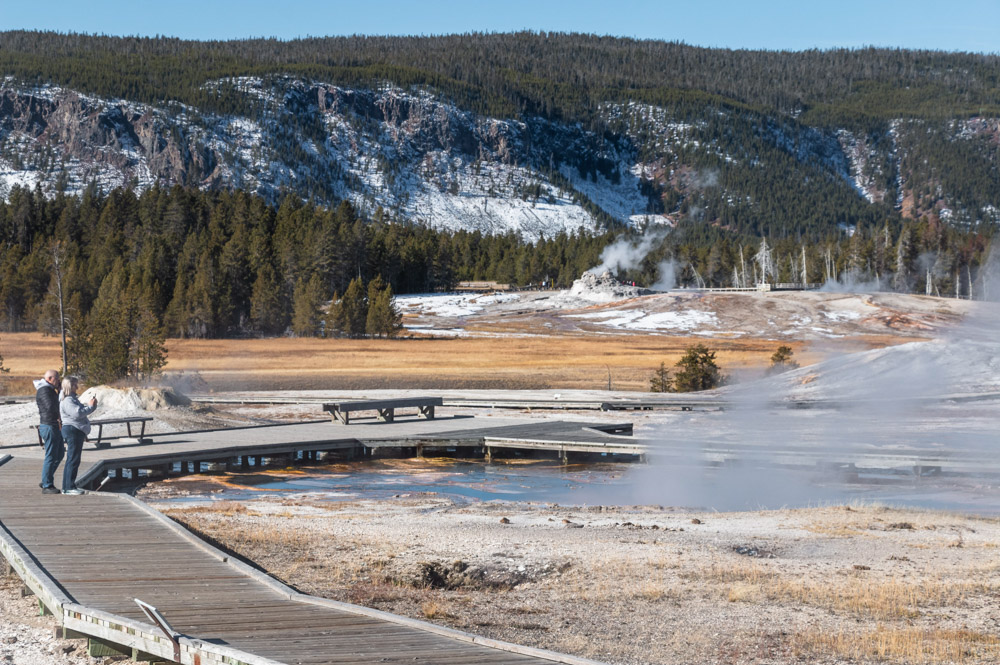
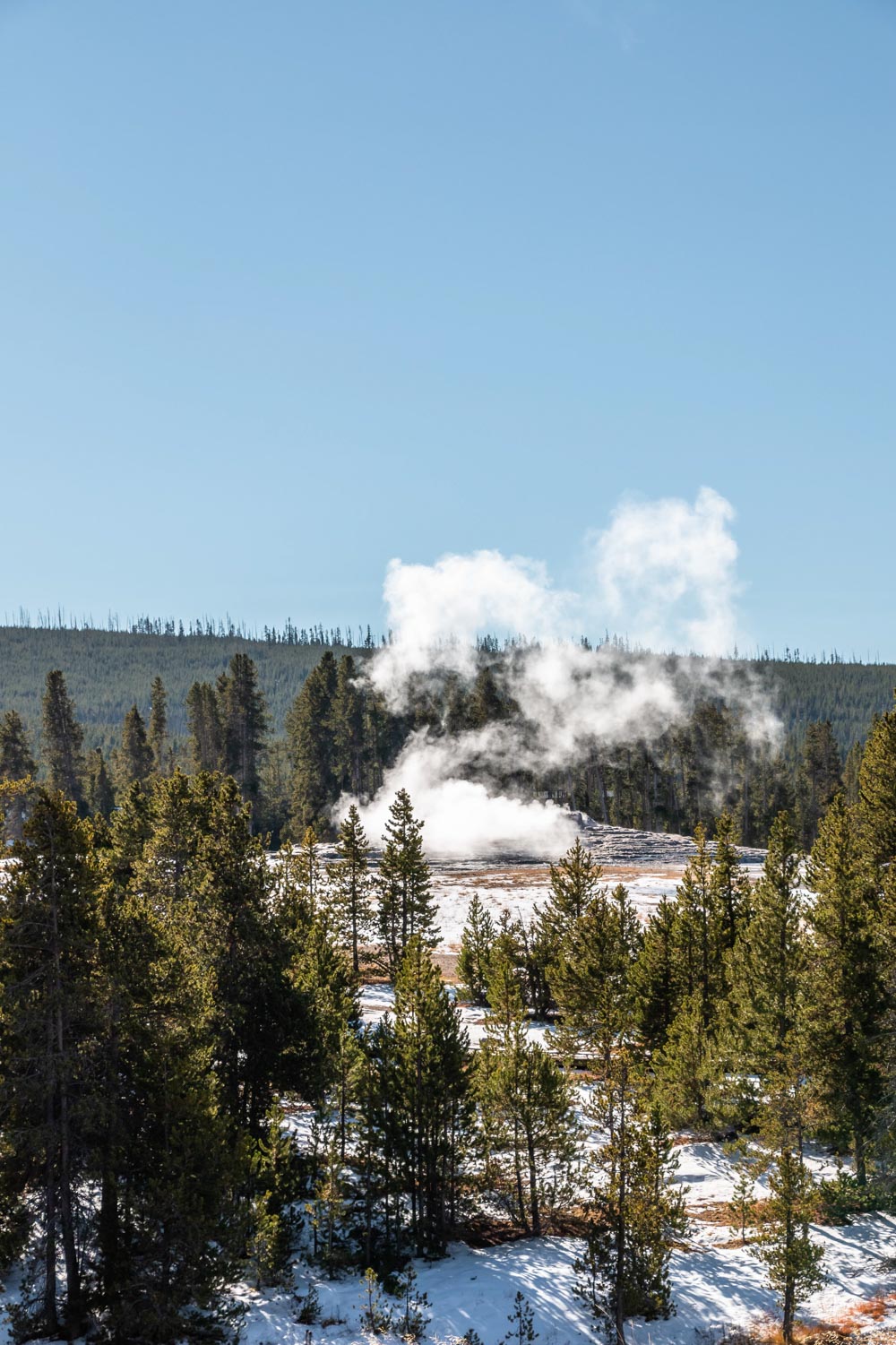
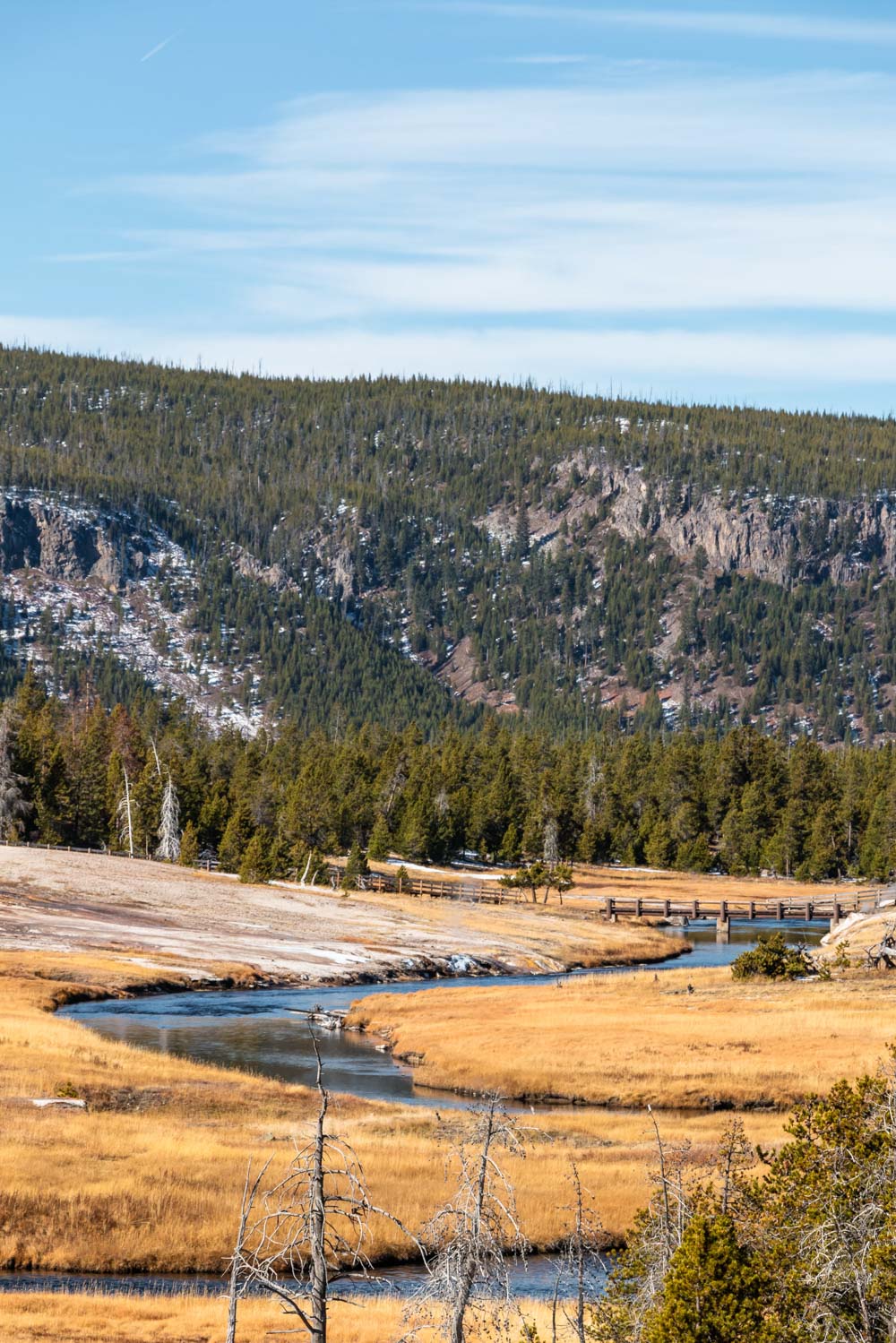
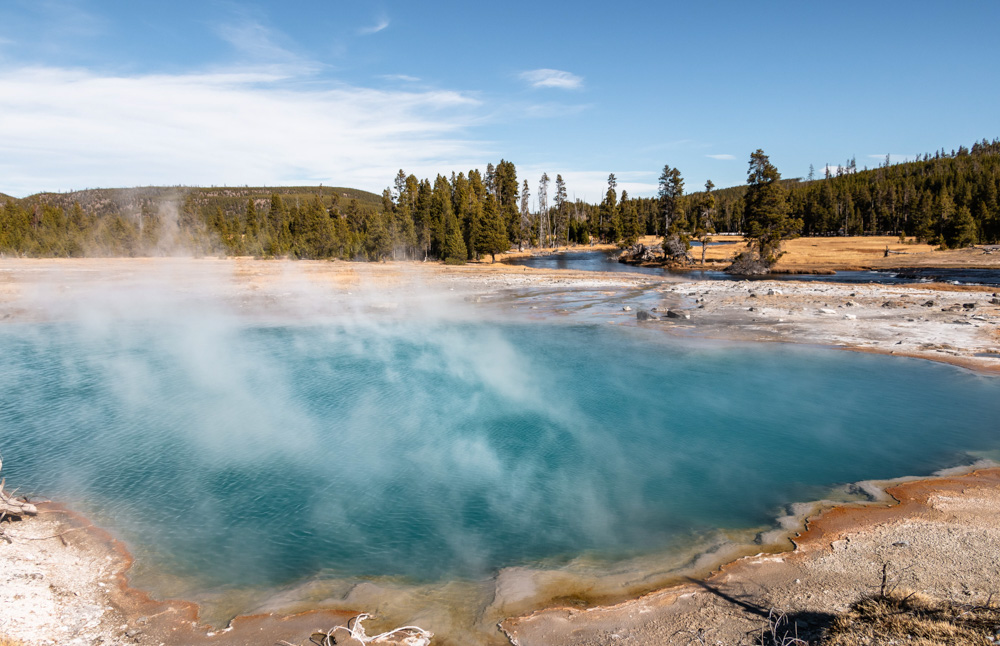
Beauty Group
As you continue down the path along the Firehole River, more groups of diverse hydrothermal features come into view. Comprising different kinds of the geysers and pools, the Beauty Group looks somewhat different. Yet similar to the majority of the Upper Geyser Basin’s features, its major hot spring has changed over the years due to the ever-evolving underground activities.
You can get a good view of the group from the boardwalk. Getting off the designated path to explore the separate members of this remarkable family in the Upper Geyser Basin is illegal and dangerous.
Round Spring Group
The Round Spring Group neighbors the Beauty Group. These hydrothermal features differ from all other natural wonders you’ve seen in the Upper Geyser Basin. Slightly cooler, the Round Spring Group is yet as frightening and harmful as the rest of the dwellers of the basin. You can safely feast your eyes on these natural miracles from a bike trail.
Giant Group
The best thing about the Upper Geyser Basin is its linear direction. The boardwalk snaking around the hydrothermal features determines your route, never letting you stray away. Simply continue along the bike path down the Firehole River to see the next astounding group of the basin’s “residents”. Dominated by Giant Geyser, the area has enjoyed long periods of activity followed by cycles of inactivity.
Daisy Group
The Daily Group sits not far from the Giant Group. Similar to the latter, it features both geysers and springs. The hydrothermal features are centered around Daisy Geyser, one of a few predictable geysers to visit in Yellowstone.
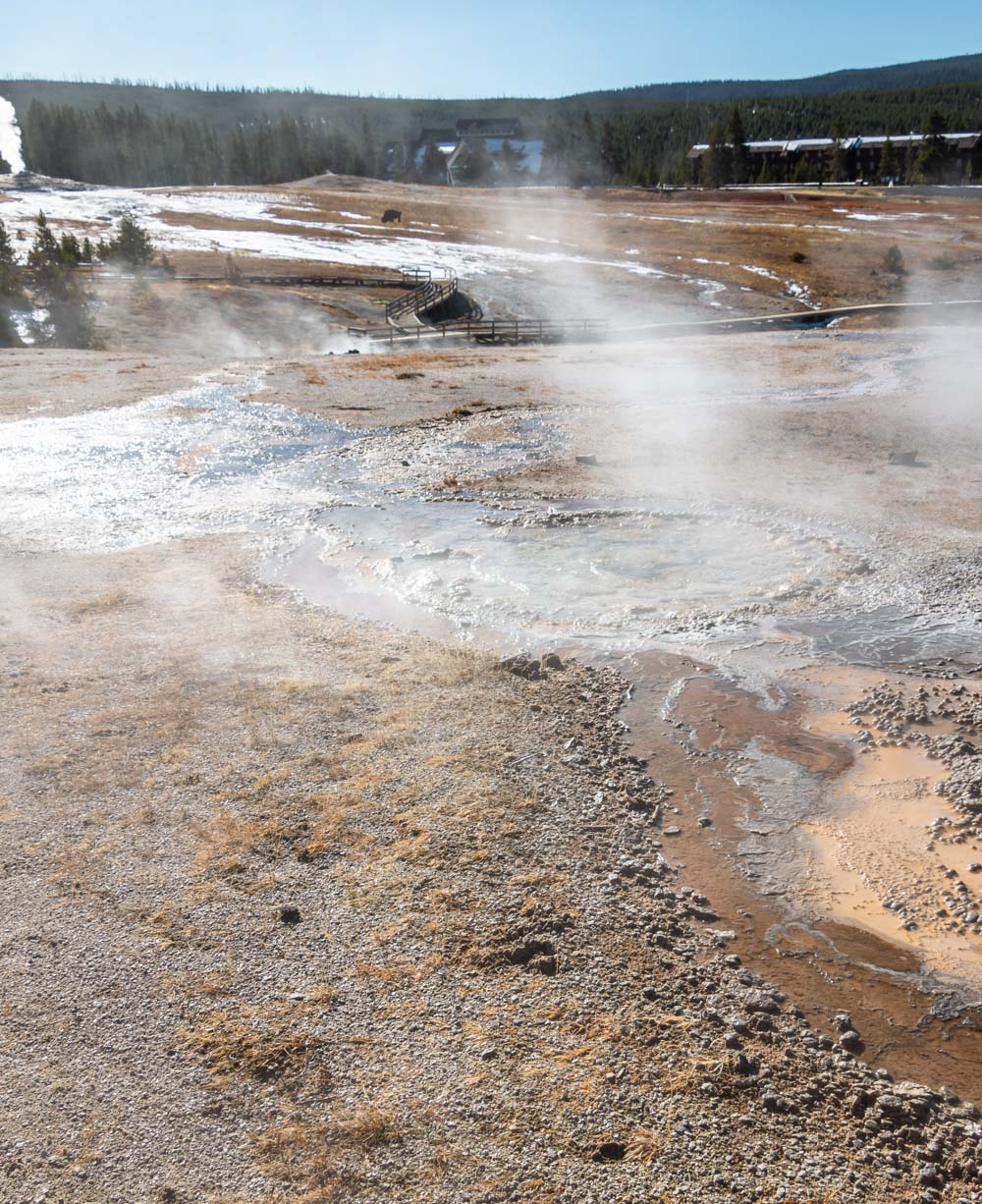
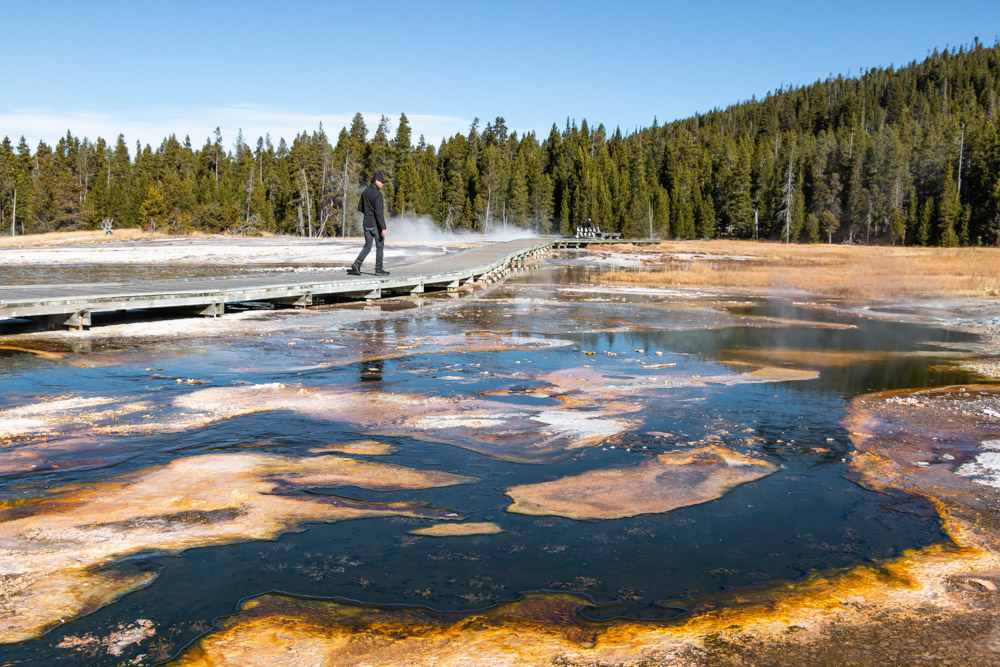
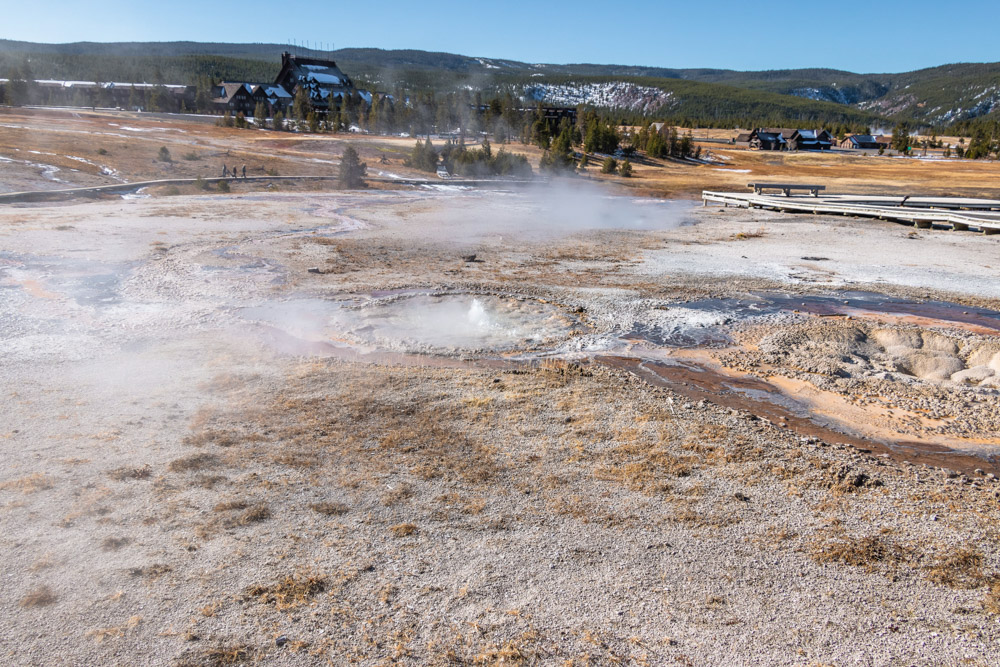
Grotto and Chain Lakes Groups
A few more groups are nestled on the banks of the Firehole River along the bike path. The finest examples of them are the Grotto and Chain Lake Groups.
Grotto Geyser
If you must choose the most prominent geyser in this area, then it certainly should be Grotto Geyser. This unique hydrothermal feature is known for its nearly 8-foot cone penetrating the sinter. Once erupted, it impresses with a long “show” that lasts from one to two hours.
The interval between the eruptions is another pattern that sets this geyser apart from all the rest. Grotto Geyser starts its next eruption in 3 hours for short mode or 9-13 hours for long modes. The temperature of the ejected water reached 201 degrees Fahrenheit.
Riverside Geyser
Riverside Geyser is known as a geyser that erupts over a river. Sitting on the bank of the Firehole River, it puts on the most spectacular show for the lucky guests that make their way to this section of the Upper Geyser Basin. The eruption happens every 6-7 hours and lasts approximately 20 minutes, shooting the water up to 75-80 feet into the air at a 60-degree angle.
Morning Glory Pool
For the majority of the travelers, a visit to the Upper Geyser Basin comes to an abrupt end after they lay their eyes on stunning Morning Glory Pool. Nestled about one mile away from the Old Faithful Inn, the feature astounds as a deep, tunnel-shaped pool with a dark blue center.
Although Morning Glory Pool looks too irresistible to not wish to test its water, this natural beauty is as deadly as the rest of the unique basin’s dwellers. Its temperature lingers at 171.6 degrees Fahrenheit.
Yellowstone’s rangers sadly confirm that the colors of Morning Glory Pool have faded a little bit as some irresponsible visitors like to dump their trash and throw coins in it. The debris accumulated over the years resulted in plugging up one of the vents of the pool. Consequently, its waters got cooler, which led to the death of some of the heat-loving bacteria surrounding the spring.
Interestingly enough, in 1950, Morning Glory Pool, unable to handle the abuse any longer, lowered its water and eventually erupted. More than 100 items, including socks, coins, handkerchiefs, and bath towels, resurfaced and were retrieved from the pool.
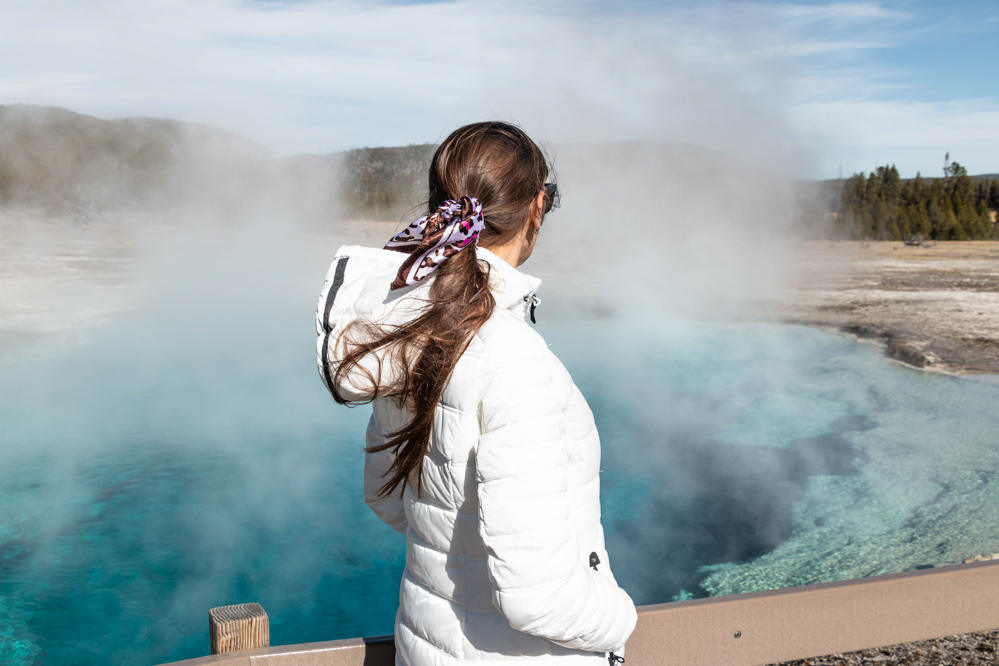
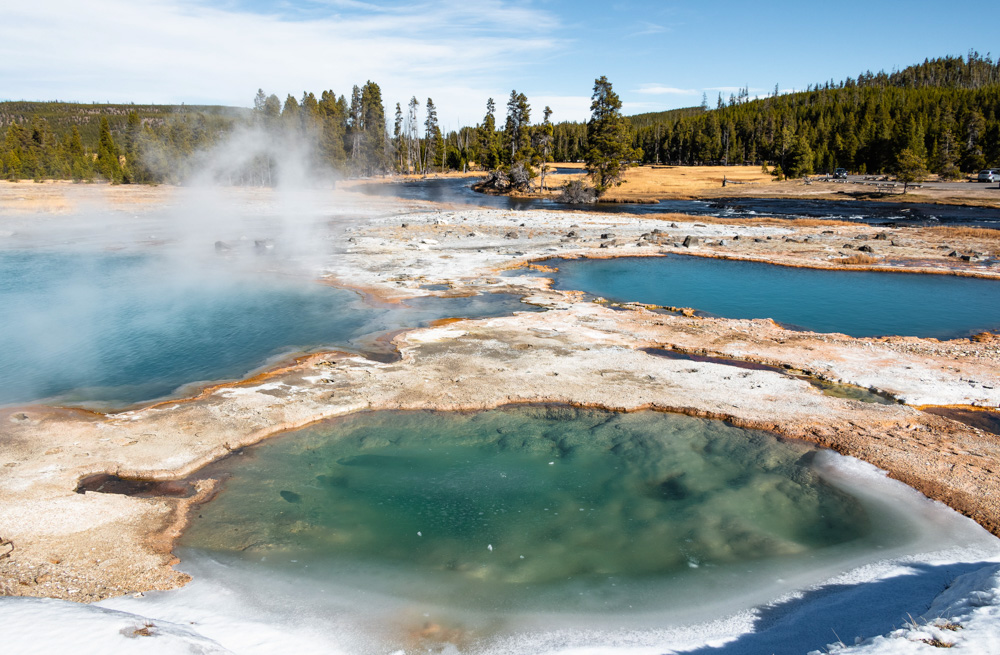
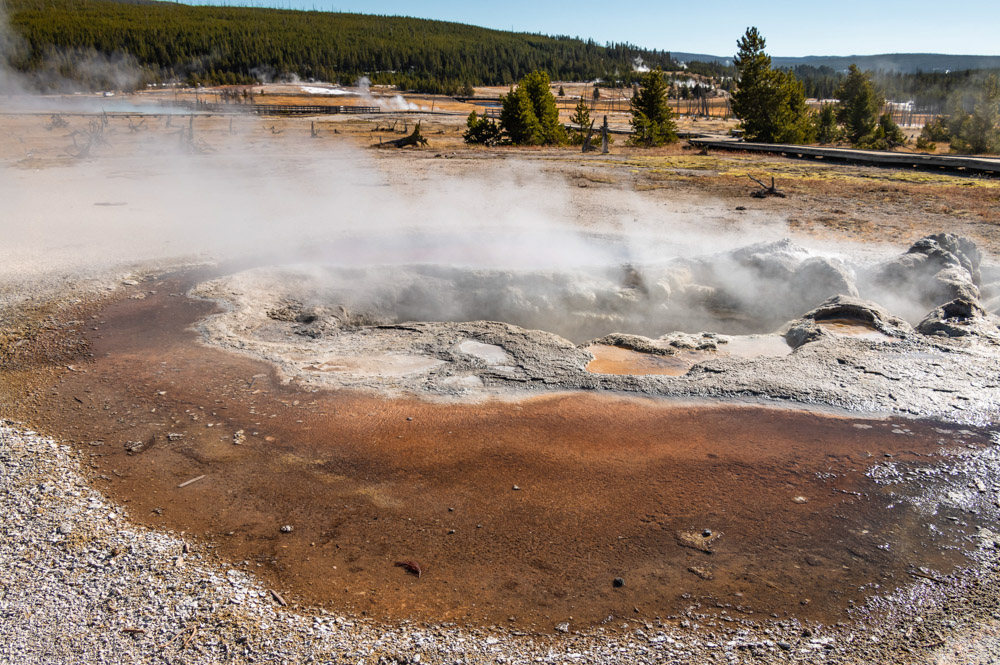
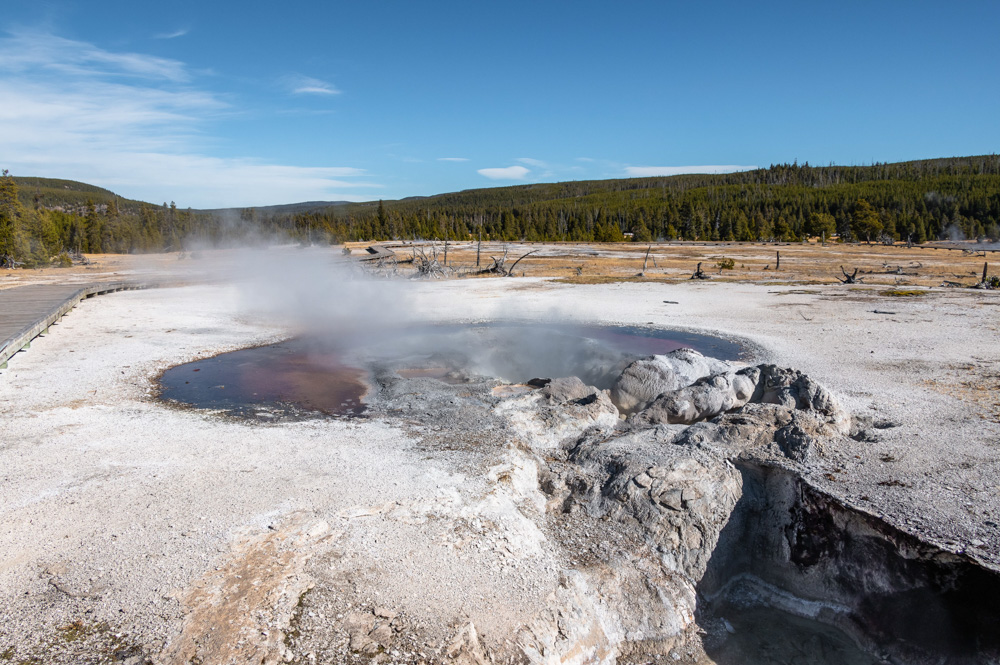
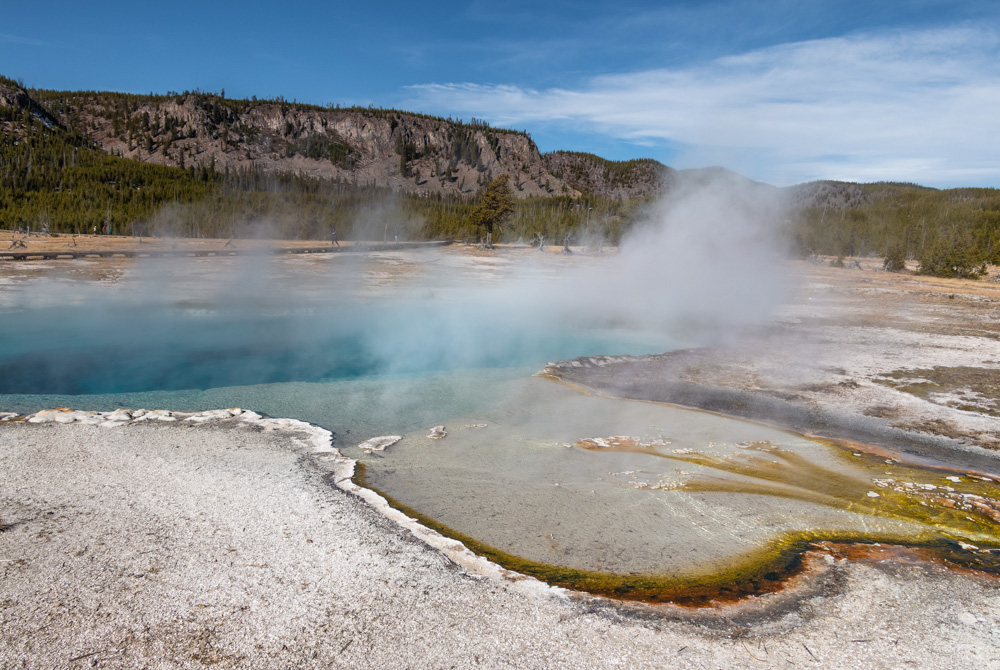
VISIT UPPER GEYSER BASIN: BLACK SAND BASIN
The next section of the Upper Geyser Basin is isolated. Located about two miles north of the Old Faithful area, it looks like a separate basin at first. This odd location, however, allows the travelers to choose how they want to visit this section. While some people hike the entire distance from the Old Faithful area to the Black Sand Basin, the rest drive here.
Name and Location
The Black Sand Basin owes its name to the fine back sand derived from volcanic glass. Some of the most colorful hydrothermal features reside here, rewarding occasional visitors with the views so different from the rest of the basin.
This rather small group of the geysers and hot pools sits along Iron Spring Creek. Its most prominent hydrothermal features include Opalescent Pool, Sunset Lake Pool, Rainbow Pool, and Emerald Pool.
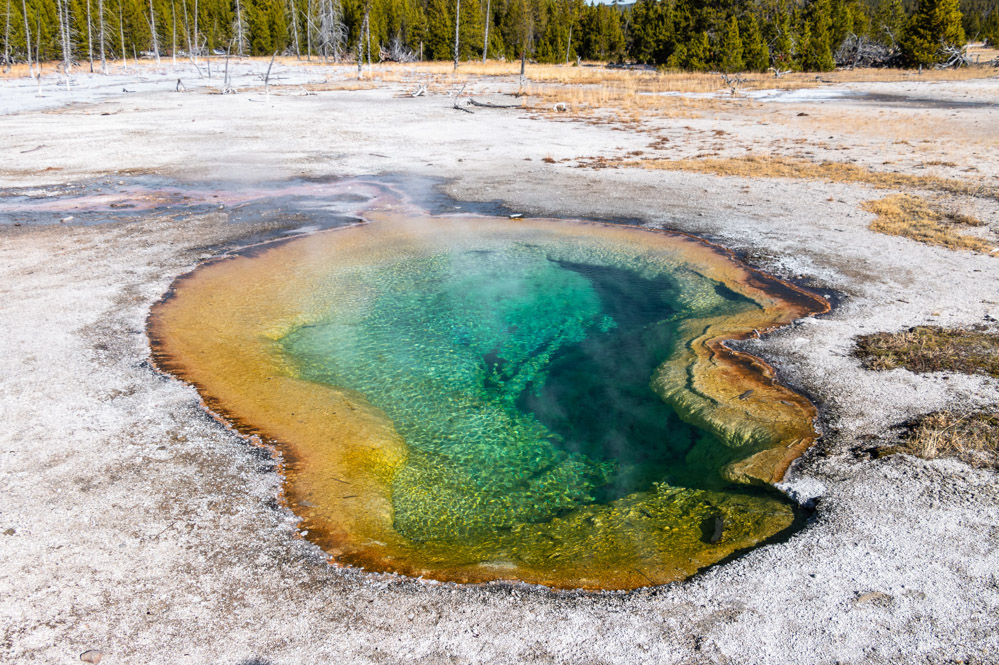
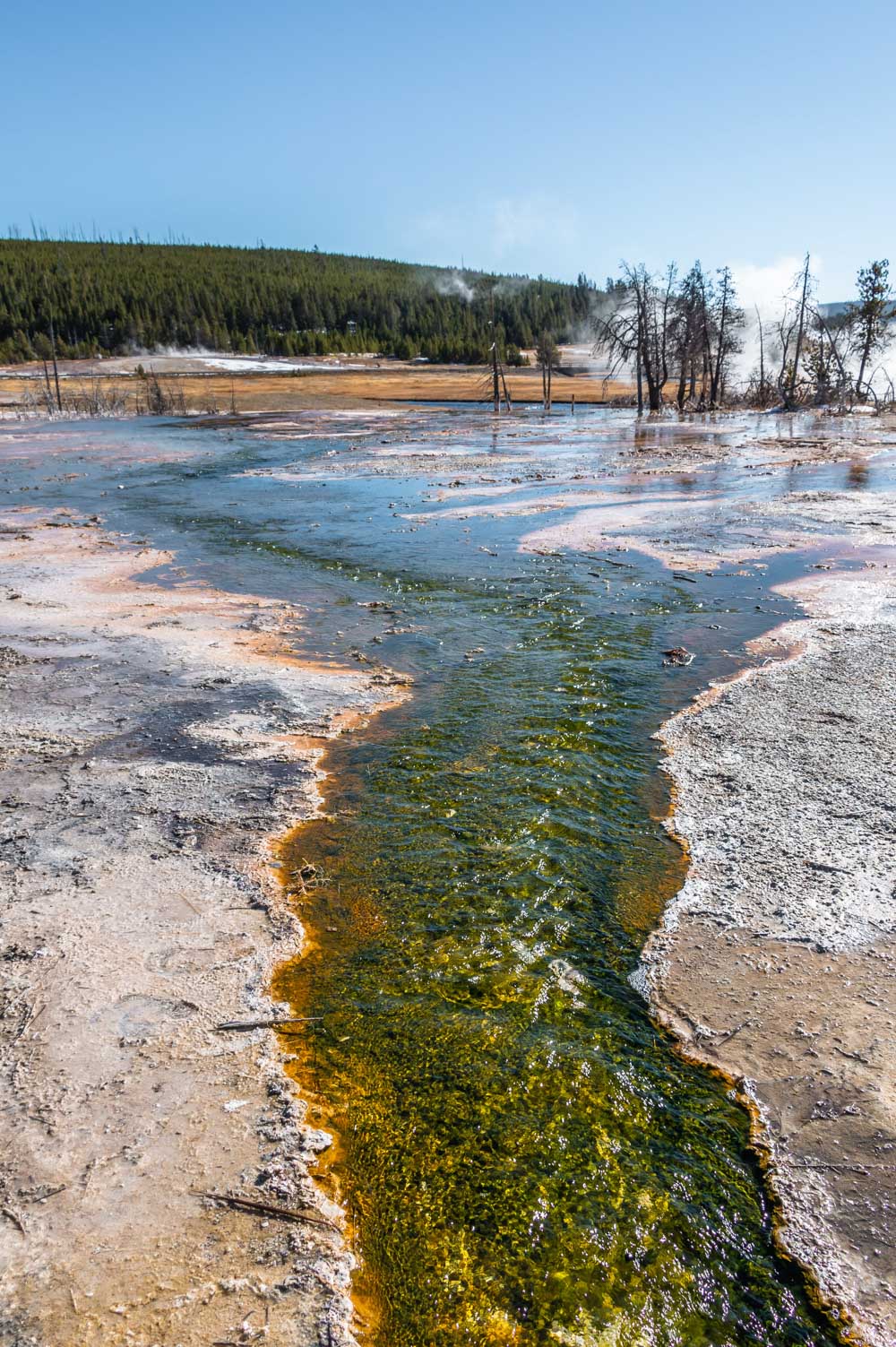
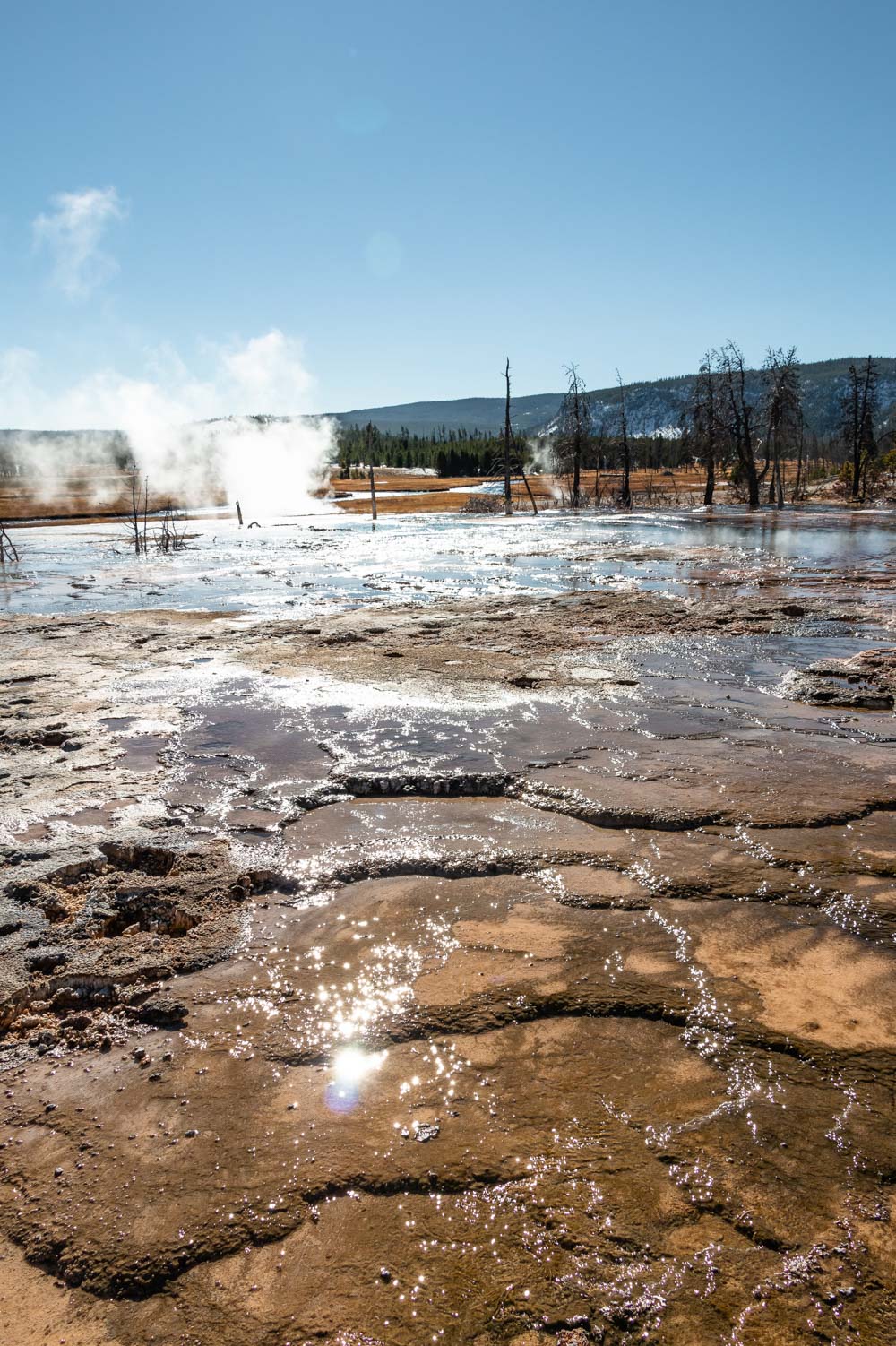
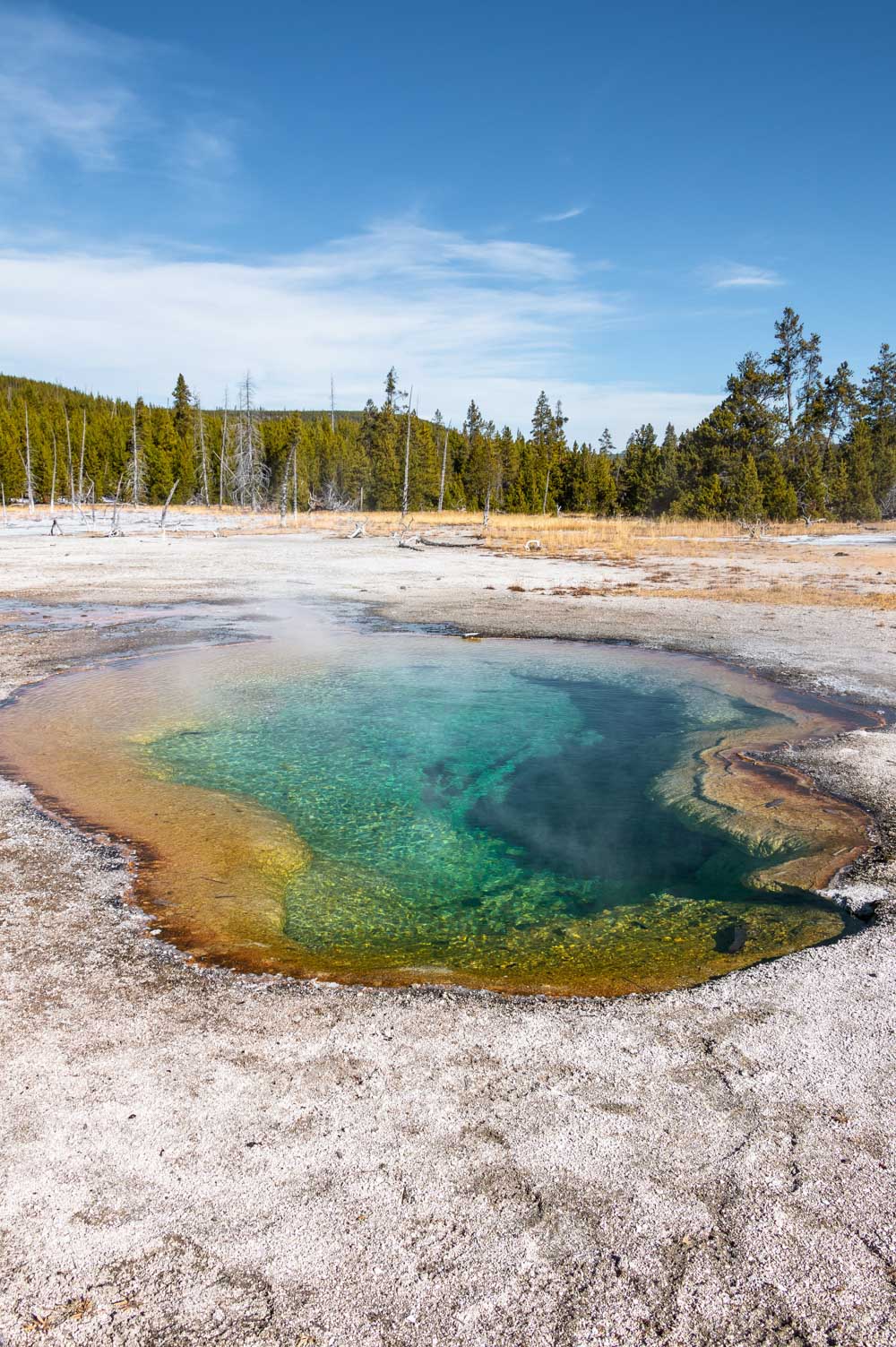
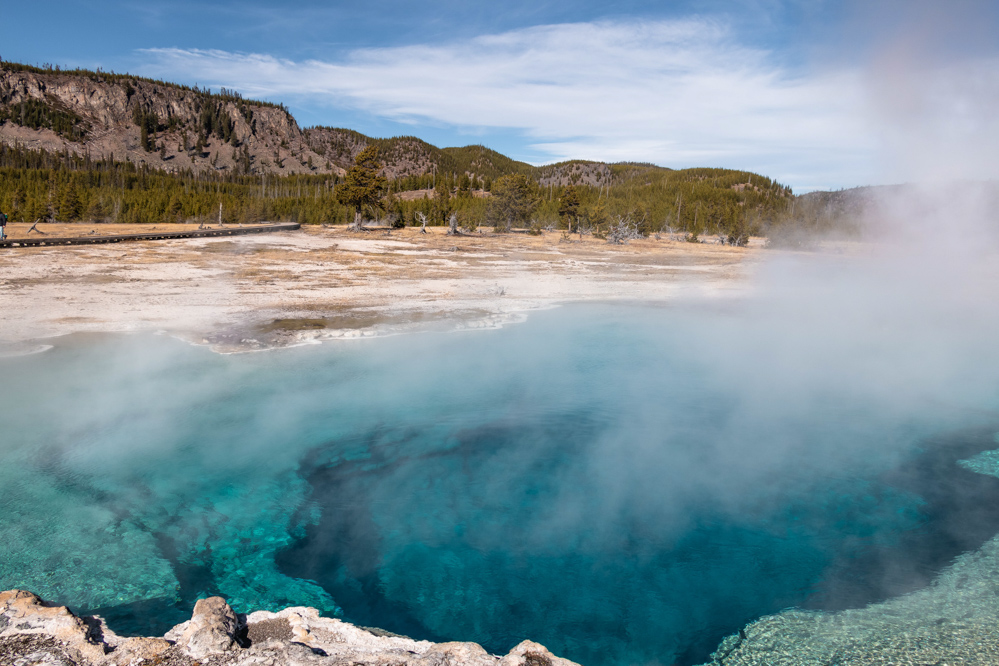
VISIT UPPER GEYSER BASIN: BISCUIT BASIN
The final section of the Upper Geyser Basin also shies away from larger crowds typical for the Old Faithful area. Sitting remotely, a few miles north on the Grand Loop Road, the place stores some of the precious gems and has practically no visitors.
The number of guests, however, depends on the season. While you can visit this isolated section of the Upper Geyser Basin and enjoy its serenity in fall or early spring, in summer, more nature enthusiasts walk down a short, 0.5-mile loop boardwalk. Yet even during this time the place never gets as crowded as the rest of the basin.
Name
Similar to the majority of the Upper Basin’s hydrothermal features, the Biscuit Basin was named for its distinct appearance. At some point, unique biscuit-shaped geyserite formations surrounded Sapphire Pool. The 1959 Hebgen Lake earthquake, however, stimulated the eruption of the spring, which washed away the famous “biscuits”.
Hydrothermal Features
Sapphire Pool, though, hasn’t changed a lot, still impressing the visitors with its pristine color and clouds of steam above its surface. Other incredible features to visit when exploring this section of the Upper Geyser Basin include Black Diamond Pool, Mustard Spring, Rusty Geyser, Shell Geyser, and Jewel Geyser.
Location
Similar to the Black Sand Basin, you can hike or bike to the Biscuits Basin from the Old Faithful area. The round trip is approximately 4 miles long and allows you to see many other hydrothermal features along the way. Driving is another option to visit this area of the Upper Geyser Basin. The place nestles off the Grand Loop Road and has its own parking lot.
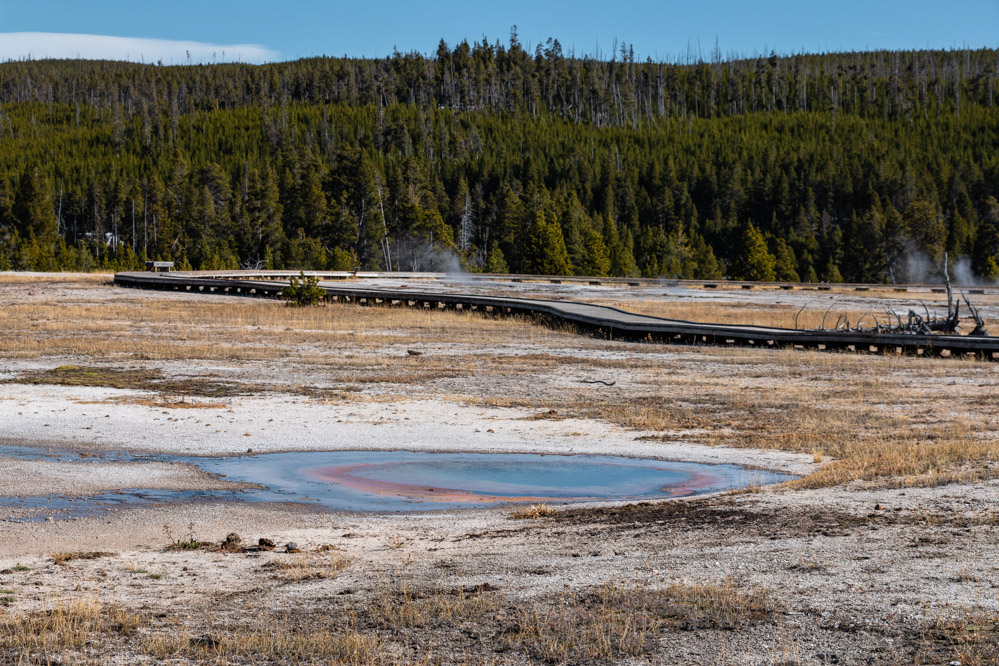
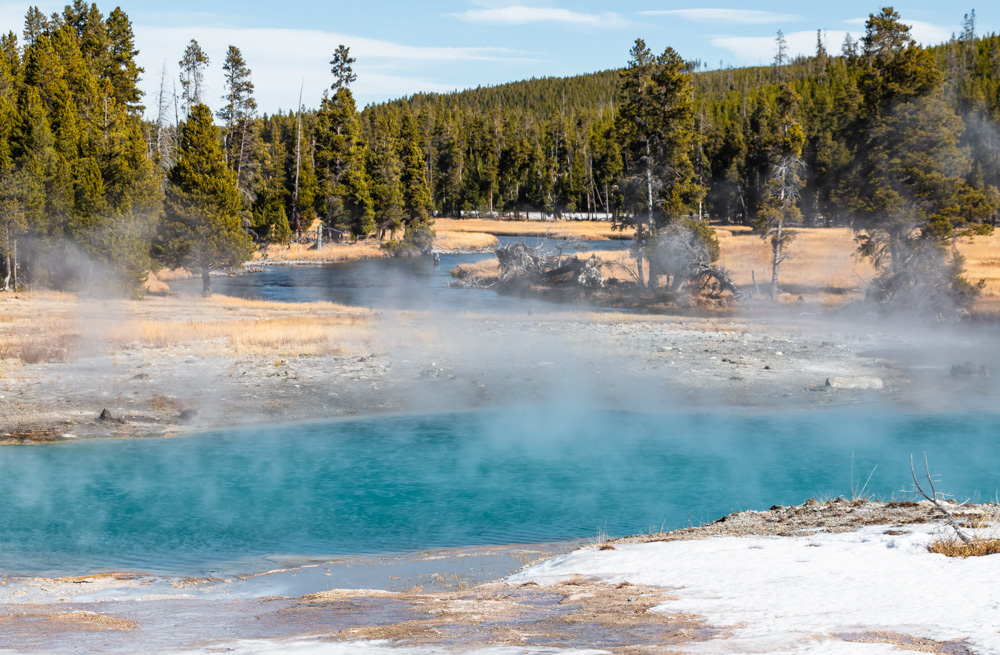
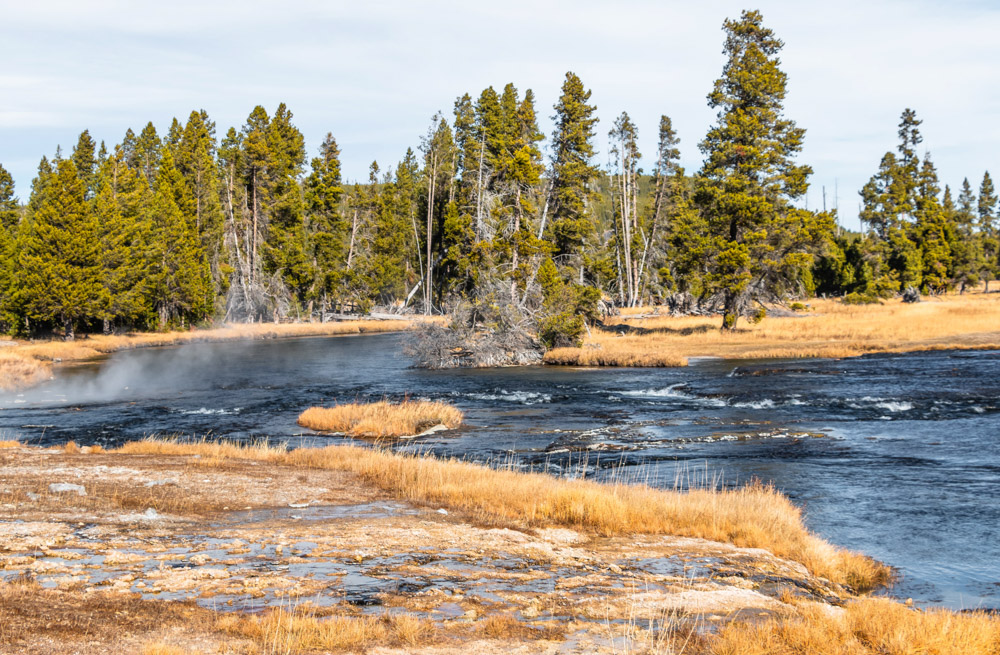
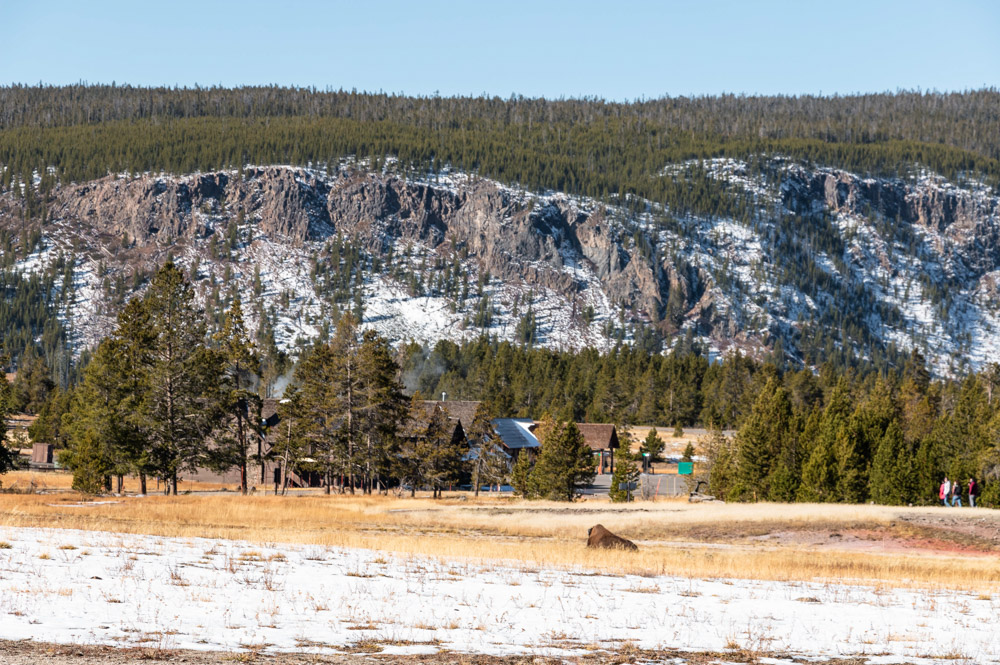
Visit Upper Geyser Basin in Yellowstone: Safety and Tips
Stay on Boardwalks at All Times when in the Upper Geyser Basin
The Upper Geyser Basin is crisscrossed with a network of the sturdy boardwalks that allow you to see some of the most popular hydrothermal features in the area. Walking off the designated wooden paths is illegal and may result in serious harm and even fatal accidents. More than 20 people died in Yellowstone National Park in the past.
Protect the Environment
The ground of the Upper Geyser Basin is fragile. The visitors are asked to stay on the boardwalks not only for their own safety but also the protection of the hydrothermal features, including the delicate heat-loving bacteria around the springs.
Don’t Test Water with Your Fingers
It’s tempting indeed. The runoff that streams under the boardwalks looks harmless and arouses your curiosity. I had to shush Roshan a few times at first before he noticed a couple of warning signs himself.
Be reasonable and keep your hands and fingers away from the hydrothermal features during your visit to the Upper Geyser Basin. The water temperatures range from 100 to 210 degrees Fahrenheit. This should make you think twice before doing something foolish.
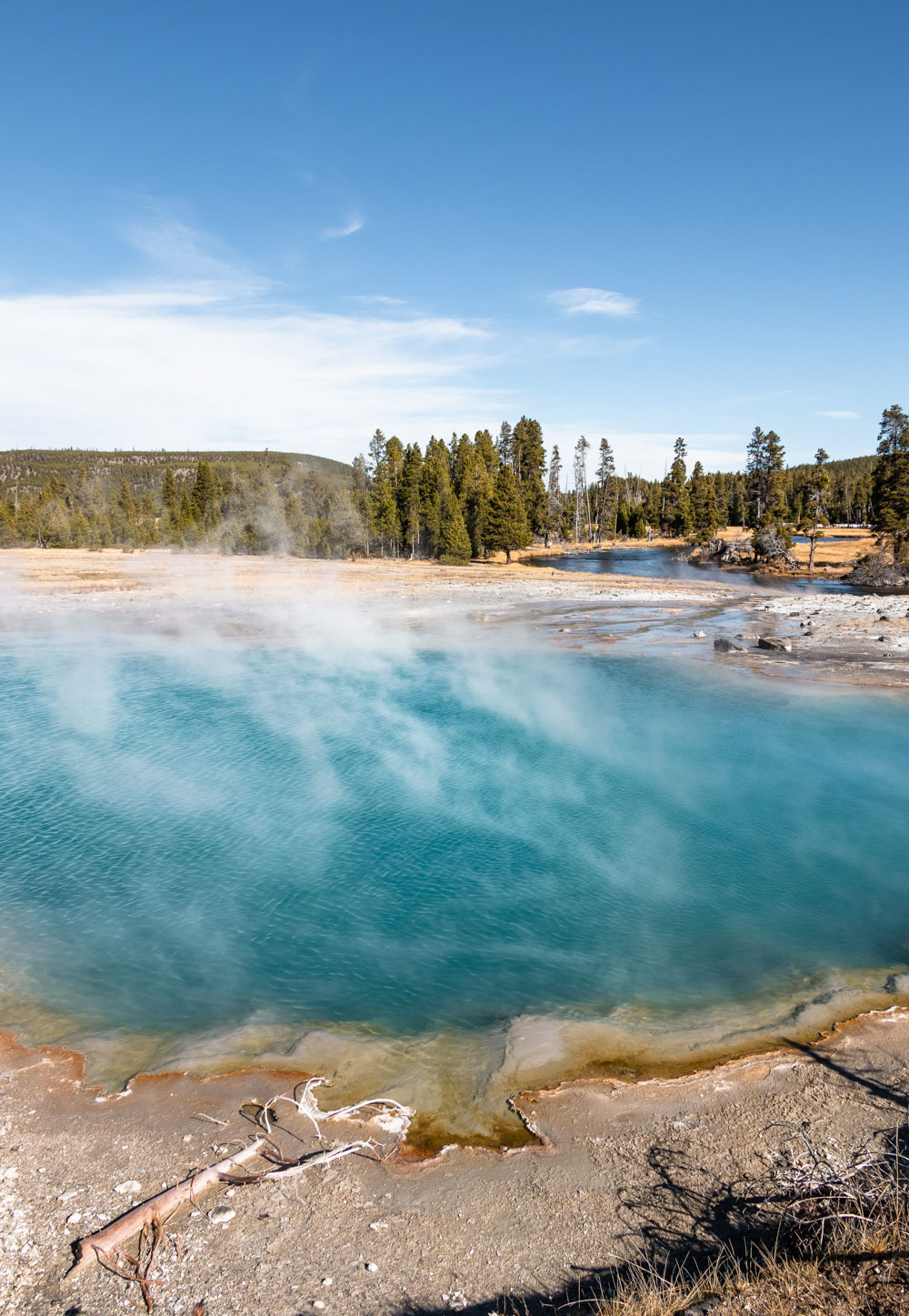
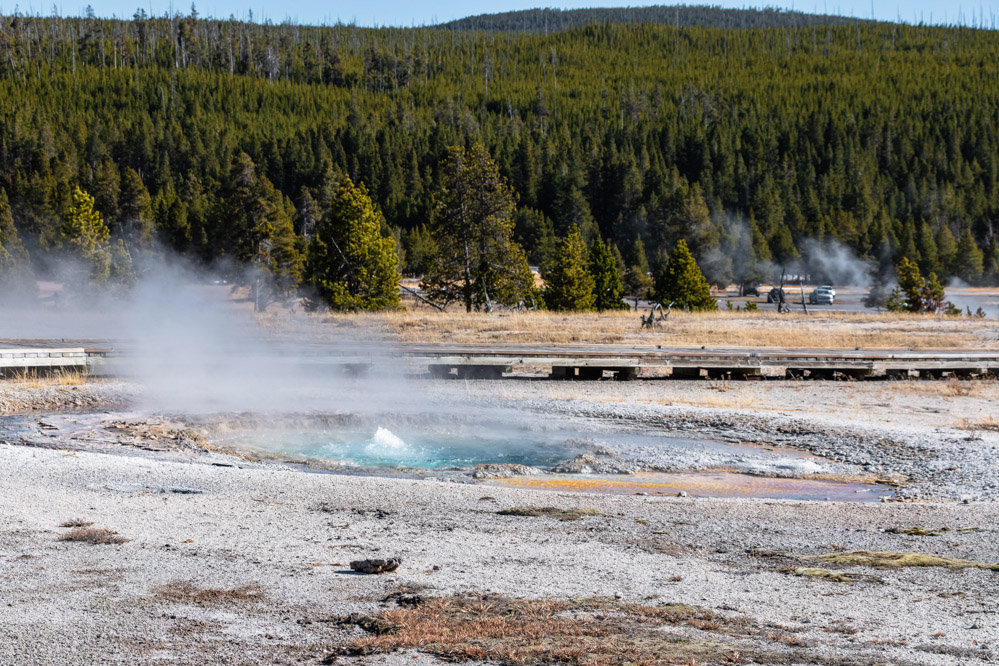
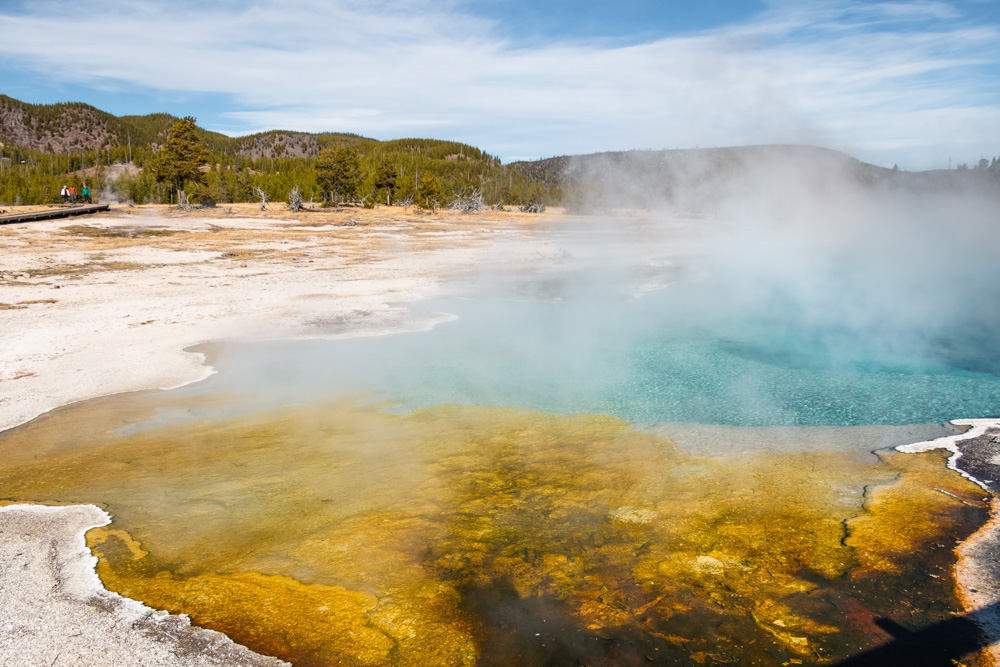
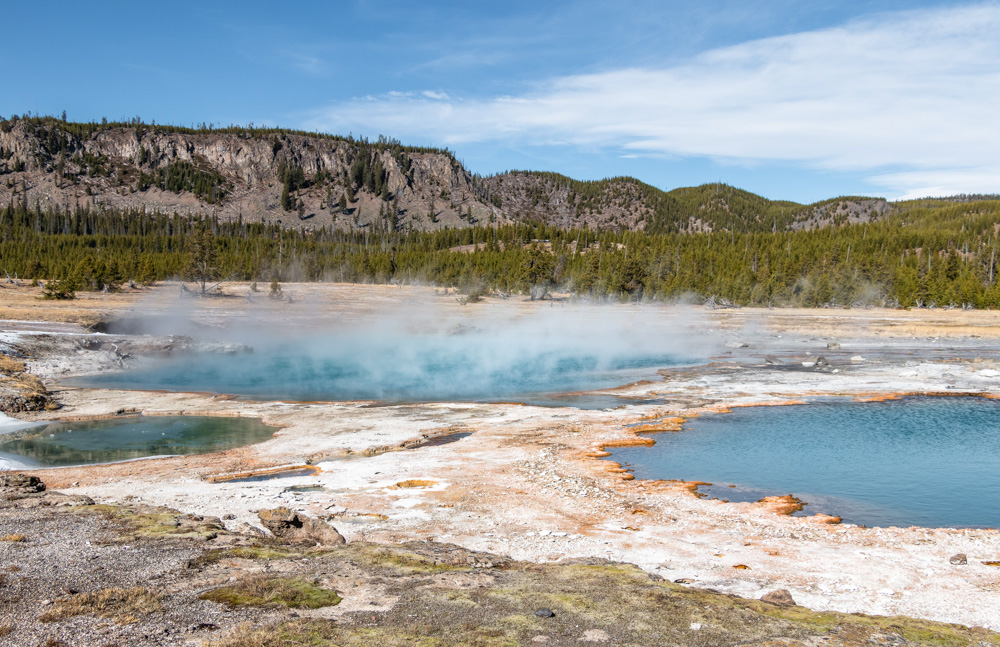
Maintain Safe Distance
It’s rare to see Yellowstone National Park’s wildlife in the Upper Geyser Basin. Yet it’s not impossible. We were lucky enough to enjoy the company of a bison a few yards away from the Old Faithful Inn. This large mammal left us speechless. Yet as harmless as it looks, the bison is still a wild animal.
Yellowstone National Park instructs its guests to keep a safe distance (25 yards) from bison and other large animals. You should stay even farther away (at least 100 yards) from bears and wolves.
Don’t Try to See Everything
The perfectionist in me was saying that we needed to see as much as possible during our visit to the Upper Geyser Basin. The truth was, though, it was impossible.
Take it easy and enjoy your visit to the Upper Geyser Basin without pushing yourself to the limit and trying to memorize names of every geyser and hot spring. Use your camera to assist you with this rather tedious task.
Beware of Smell
The Upper Geyser Basin stinks, literally. The nasty smell lingers in the air and offends your senses enormously. You get used to it eventually. People with a heightened sense of smell might have issues with this persistent odor.
If you are one of them, break your visit to the Upper Geyser Basin into short trips. Explore the area for 30 minutes or so before stepping out from it for a breath of fresh air. Resume your visit where you stopped and explore the other sections of the Upper Geyser Basin until the smell forces you to look for refuge again. Repeat as many times as you need.
The Final Note
This concludes our guide to the Upper Basin and its remarkable hydrothermal features. If you are looking for more information about Yellowstone National Park, check out our guides to the Midway Geyser Basin and its stunning Grand Prismatic Spring.
Yellowstone National Park was just one of many stops during our Boise to Yellowstone road trip. Prior to venturing into the remarkable kingdom of geysers and hot springs, we spent a day admiring photogenic sites and watching (at least trying to) diverse wildlife of Grand Teton National Park.
Note: During our recent trip to Banff National Park, I expected to find similar boiling hot springs at the Cave and Basin National Historic Site. Turns out, the place looked nothing like Yellowstone National Park. Nevertheless, it was a beautiful short trip to complete our adventures in the Canadian Rocky Mountains.
